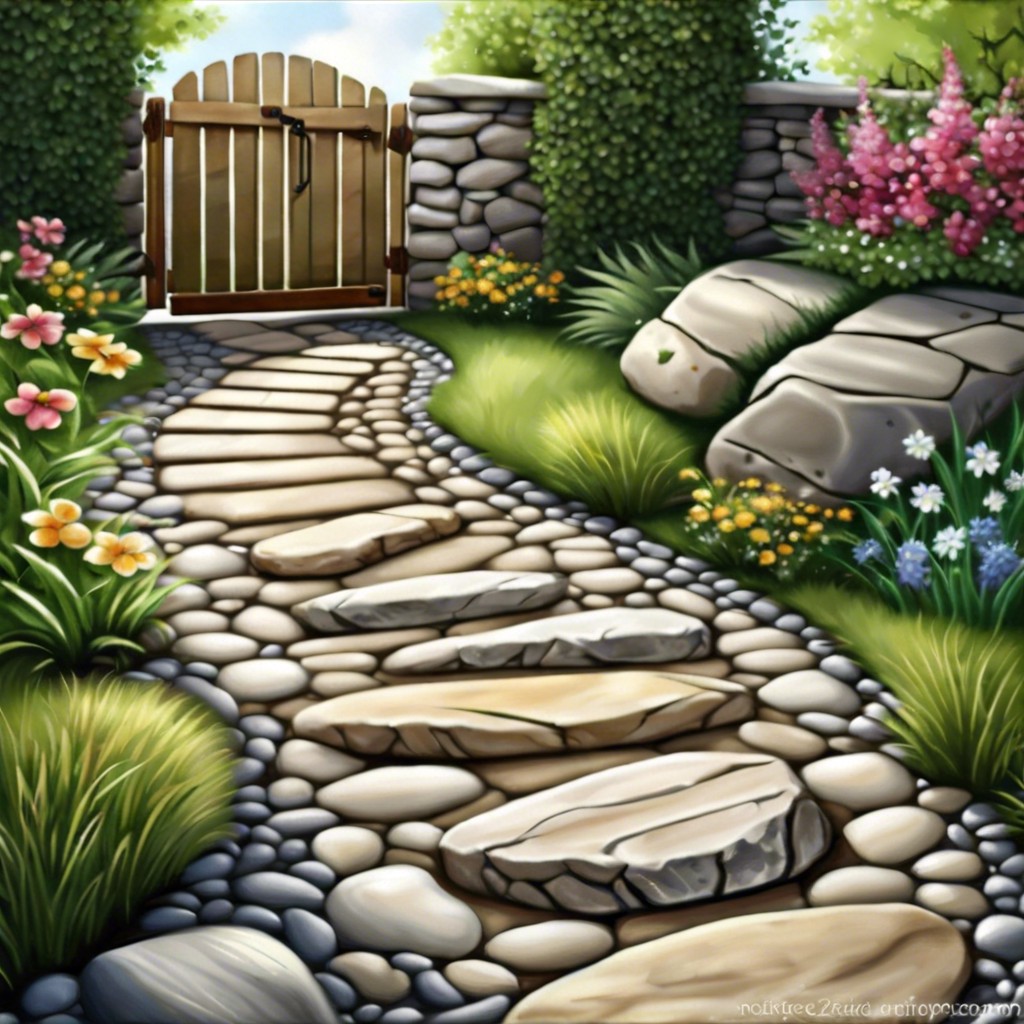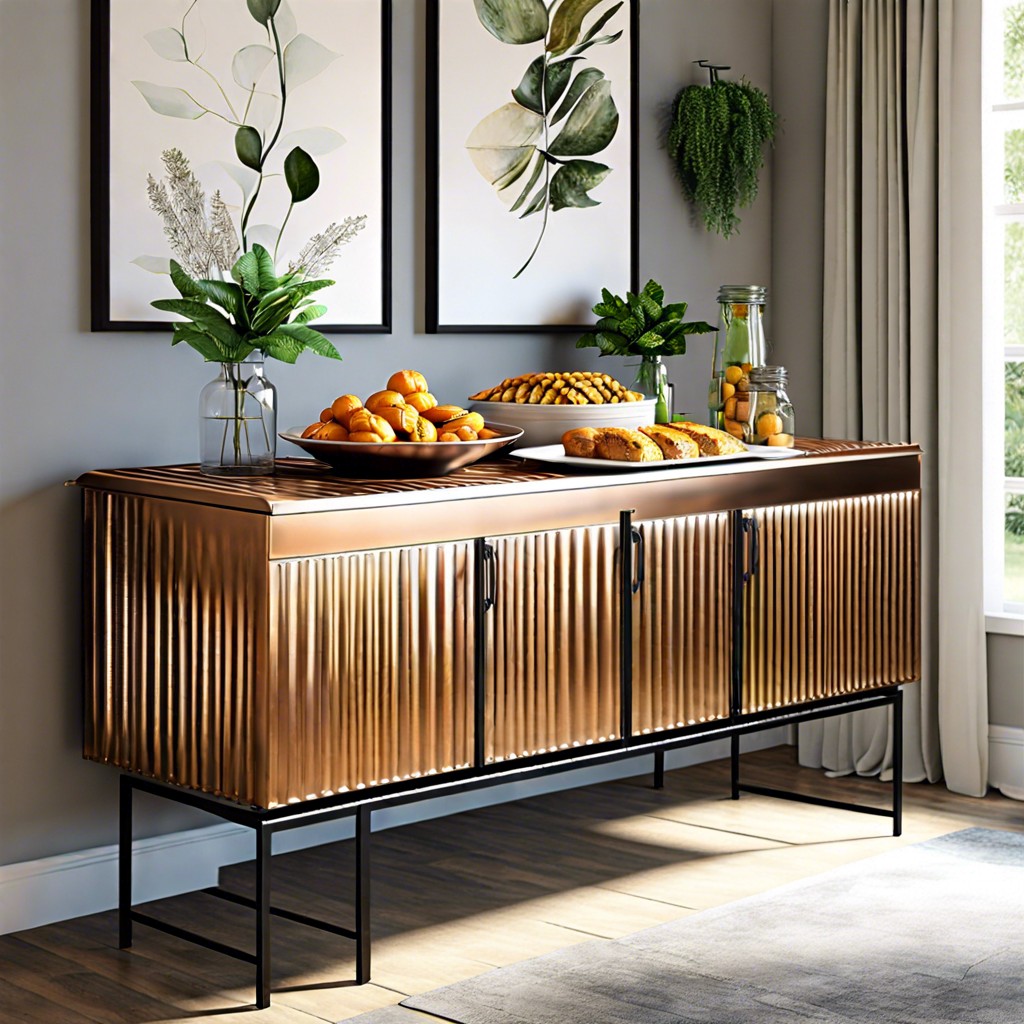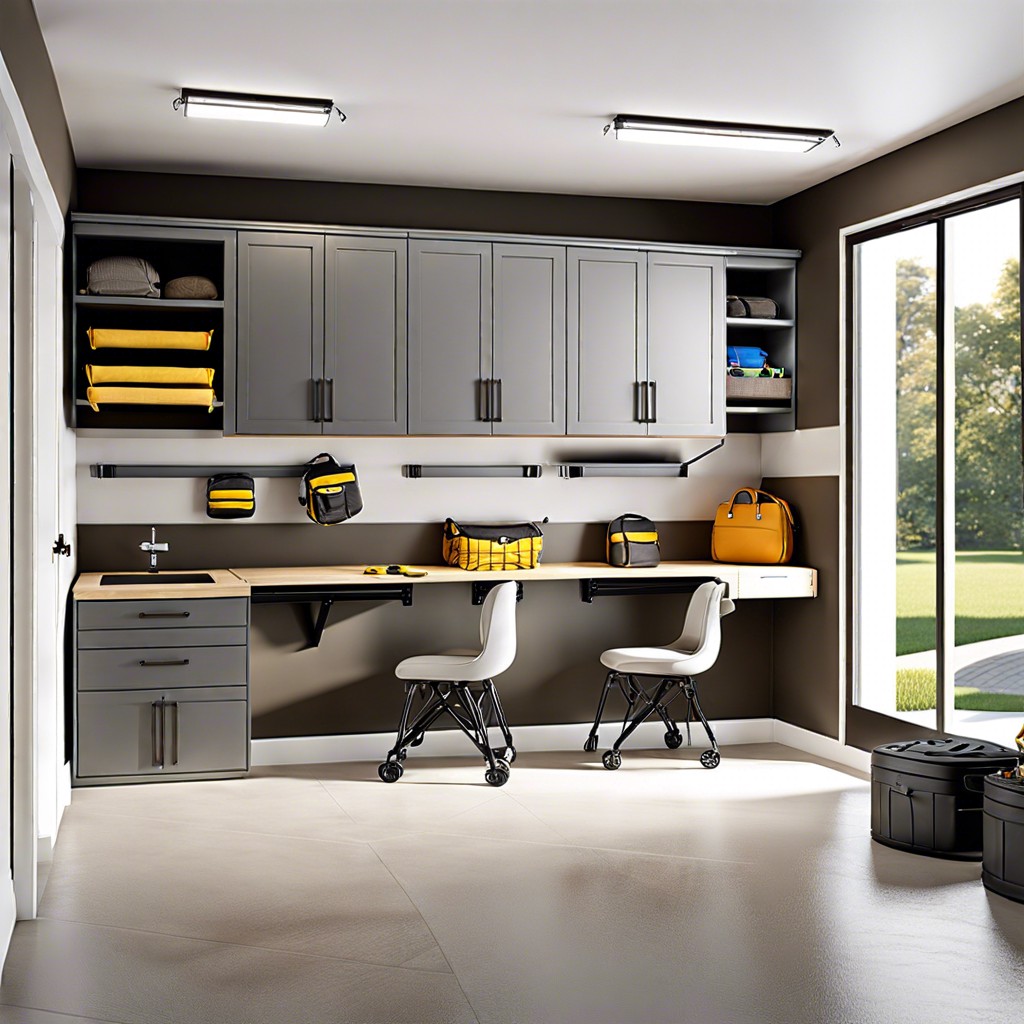Last updated on
Delve into the world of DIY succulent frames because transforming your living space into a chic, green oasis doesn’t have to come with a hefty price tag.
This article includes my original designs. Some of them may be exaggerated to make a point — that’s my style. Enjoy them for your inspiration!
Dive into the world of DIY succulent frames! While there’s a sea of familiar ideas floating on the internet, this article targets to unravel some fresh, unique perspectives.
From quirky designs to unexpected materials, prepare to challenge your creativity.
Of course, a nod to classic concepts is necessary, for which we’ve rounded up resources to the finest existing ideas, nestled for you at the end of this piece.
This unique journey doesn’t just aim to replicate, but to invent new paths in the enchanting terrain of succulent frames.
So, gear up to discover a list that’s designed to fuel your creativity, and quite simply be a treasure chest of distinct ideas.
Here’s to creating wonders, one succulent frame at a time!
Key takeaways:
- Consider size, depth, and material when selecting a frame.
- Choose succulents that stay compact and have compatible light and watering needs.
- DIY succulent frames make thoughtful and personalized gifts.
- Repurpose old picture frames to create unique succulent displays.
- Get creative with design, incorporating unusual shapes, patterns, and mixed media.
Selecting the Perfect Frame for Your Succulent Art

When hunting for a frame that will complement your succulent arrangement, consider size, depth, and material. A frame with a depth of at least 2 inches ensures ample space for soil and roots. Wood frames are a sustainable choice offering a natural look that pairs well with greenery, while metallic frames contribute a modern touch. Opt for a size that suits your space and the scale of succulents you plan to use.
For durability, especially if the frame will be hung outdoors, ensure it is treated to withstand the elements. Remember to check for a strong backing to support the weight of the soil and plants. Lastly, think about the color and texture of the frame as it should complement, not overpower, the beauty of your succulents.
Choosing the Right Succulents for a Frame
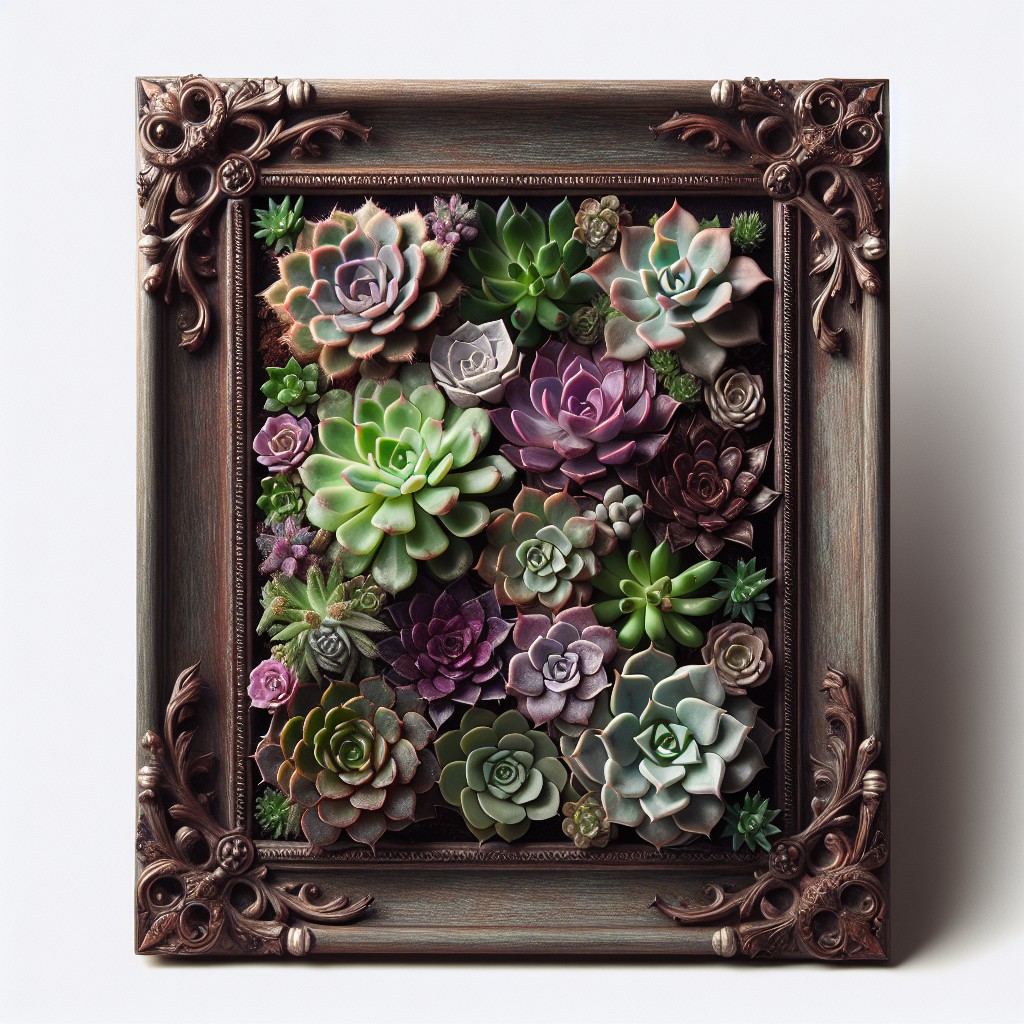
When selecting succulents for your frame, consider growth habits and environmental needs. Opt for varieties that stay compact, like Echeveria or Hens-and-Chicks, to maintain the frame’s appearance. Avoid fast-growing or large species which could outgrow the space quickly.
Ensure the chosen succulents have compatible light and watering requirements to thrive together. Prefer species that prefer indirect light for indoor frames to avoid sunburn. Fleshy-leaved succulents typically retain more water and may be more forgiving of infrequent watering, ideal for living frames.
Succulents with a variety of textures and colors add visual interest. Combine rosette shapes with trailing varieties such as String of Pearls for depth. Remember, cuttings or smaller plants are best for starting your frame, as they root easily and adapt to the shallow soil depth.
DIY Succulent Frame As a Gift Idea
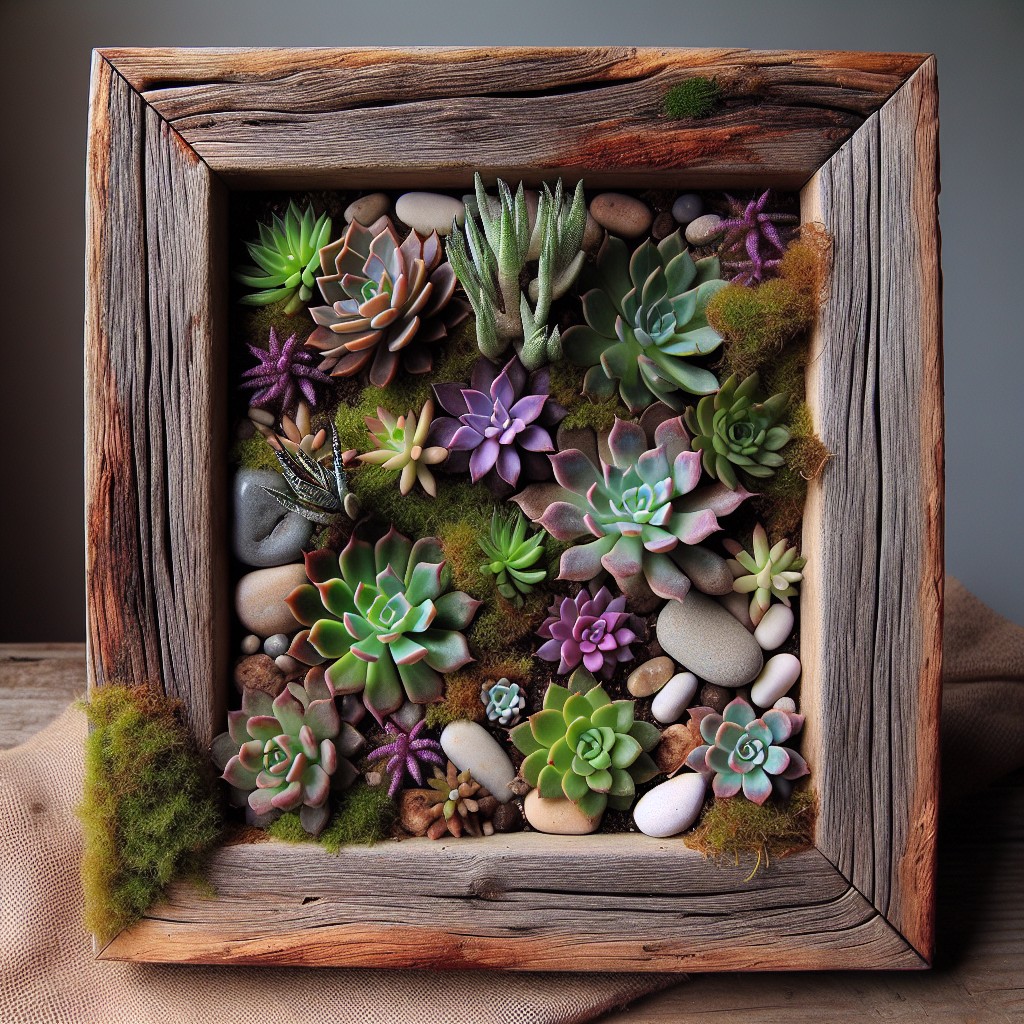
Crafting a DIY succulent frame is a thoughtful and personalized present that’s ideal for housewarmings, birthdays, or as a ‘just because’ gift.
Tailor the selection of succulents to the recipient’s personal style or the décor of their space.
Customize the frame size, color, and texture to fit their taste or interior design scheme.
Consider adding a sentimental touch by repurposing a frame that holds significance to both giver and receiver.
Include care instructions to assist the recipient in maintaining the beauty of their living art.
For an extra-special touch, pair the succulent frame with a small watering bottle or decorative stones.
This sustainable gift is not only a delightful addition to any home but also serves as a lasting representation of your considerate gesture.
Repurposing Old Picture Frames Into Succulent Displays
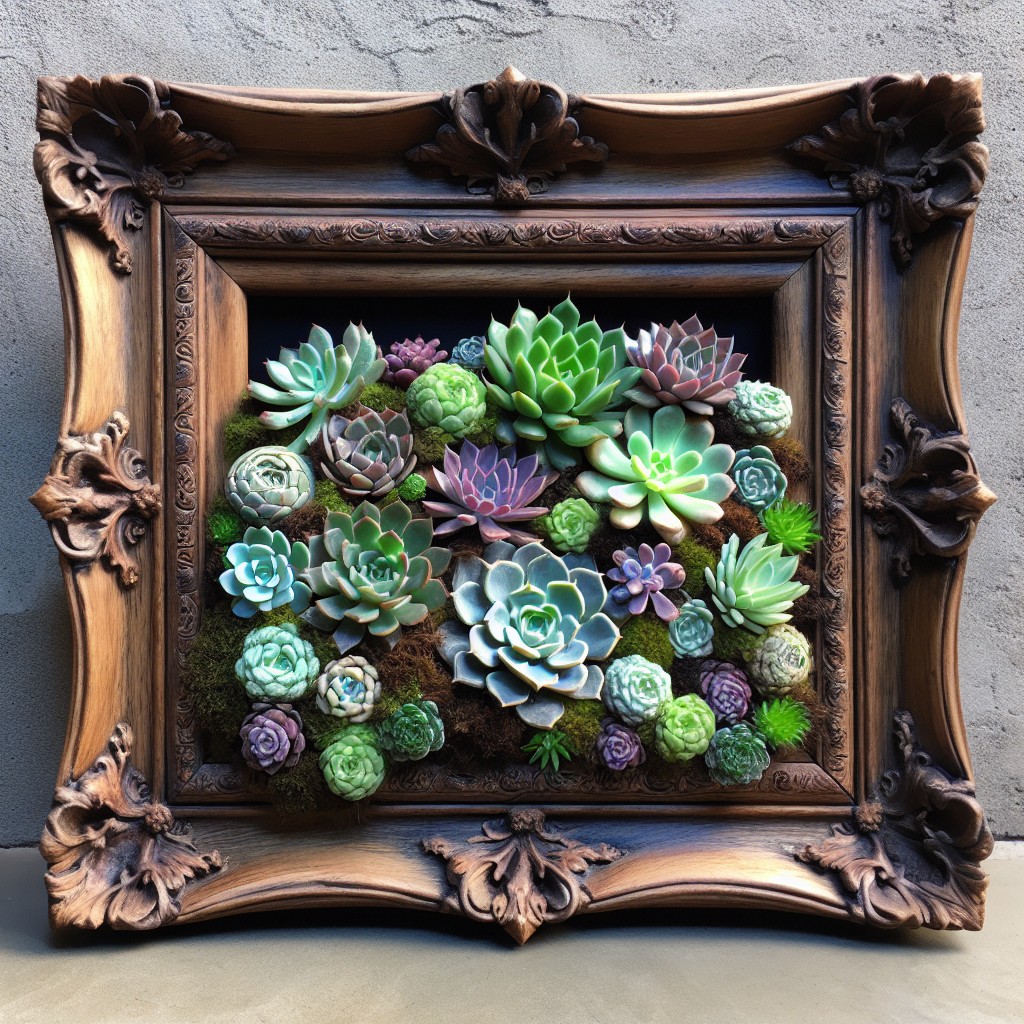
Transforming an old picture frame into a succulent display breathes new life into both the frame and your living space. Here are several key points to consider during the process:
- Frame Selection: Opt for sturdy, deeper frames to accommodate soil and plants. Vintage wood or shadow box frames work well.
- Prepping the Frame: Remove any backing, glass, or content and sand down rough edges for safety. Clean thoroughly before use.
- Backing and Edges: Fit the back with a plywood cutout sealed with silicone caulk to prevent water damage. Mesh wire can be added to hold the soil in place while allowing root growth.
- Soil and Moss: Lay sphagnum moss against the mesh, adding cactus mix soil behind it to create an adequate growing environment.
- Plant Arrangement: Arrange succulents by size, texture, and color before planting to ensure an aesthetically pleasing composition.
- Watering: Succulents require minimal water. Ensure your repurposed frame includes a way to drain or is watered sparingly to prevent rot.
- Mounting: Securely attach hardware to the frame for mounting, making sure it can support the weight when filled with plants and soil.
By following these considerations, you’ll craft an engaging, eco-friendly showcase for your succulents that reflects both your personality and a flair for creative recycling.
Care Tips for Framed Succulent Plants

Ensure your framed succulent thrives with these essential care tips:
- Light: Position your frame in a bright area with indirect sunlight. Too much direct sun can scorch the leaves, while too little will cause stretching.
- Watering: Use a spray bottle or syringe to water sparingly, allowing the soil to dry between sessions. Overwatering can lead to root rot, especially in non-draining frames.
- Soil: A well-draining soil mixture is crucial. Combine potting soil with sand or perlite to improve drainage and aeration.
- Feeding: Feed monthly with a diluted, balanced fertilizer during the growing season. Avoid feeding in winter when growth slows.
- Pruning: Trim back overgrowth to maintain the frame’s design. This will also encourage the plants to grow fuller.
- Dusting: Gently dust leaves with a soft brush to keep them clean, enhancing photosynthesis and deterring pests.
Innovative Designs for Your Succulent Frame
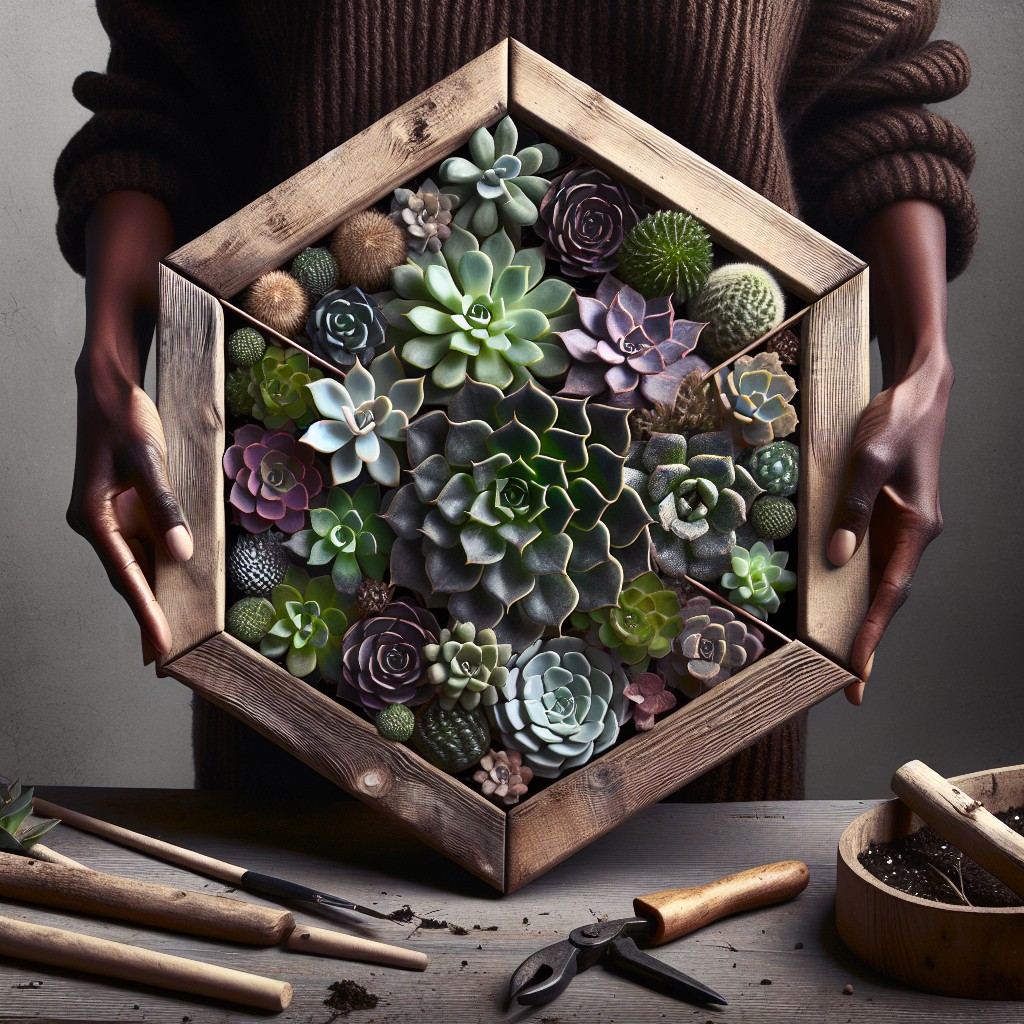
Push the boundaries of creativity by incorporating unusual shapes and patterns into your frame. Consider a circular frame for a modern twist or craft geometric patterns with wood to create compartments for different succulents. Instead of traditional framing, why not build a living mosaic with succulents filling in for colored tiles?
Explore the concept of thematic storytelling with your frames. Create a beach scene with sand-toned succulents in a shadowbox or a desert landscape in a panoramic frame.
Embrace the vertical space by designing a tiered frame, allowing for a lush green wall effect. Consider a ladder-style set-up with multiple small frames, each featuring a different succulent variety, to create an eye-catching vertical garden.
Incorporate interactive elements, such as a chalkboard paint border where you can label the plants or jot down watering reminders.
Experiment with mixed media. Surround your succulents with small stones, driftwood, or even incorporate fairy lights for an enchanting nighttime display.
Lastlly, consider functionality. Create a succulent frame that doubles as a planter box or integrates small shelves for additional decorative objects or practical items. This gives your succulent display a dual purpose while still maintaining its aesthetic appeal.
Using Recycled Materials for DIY Succulent Frames
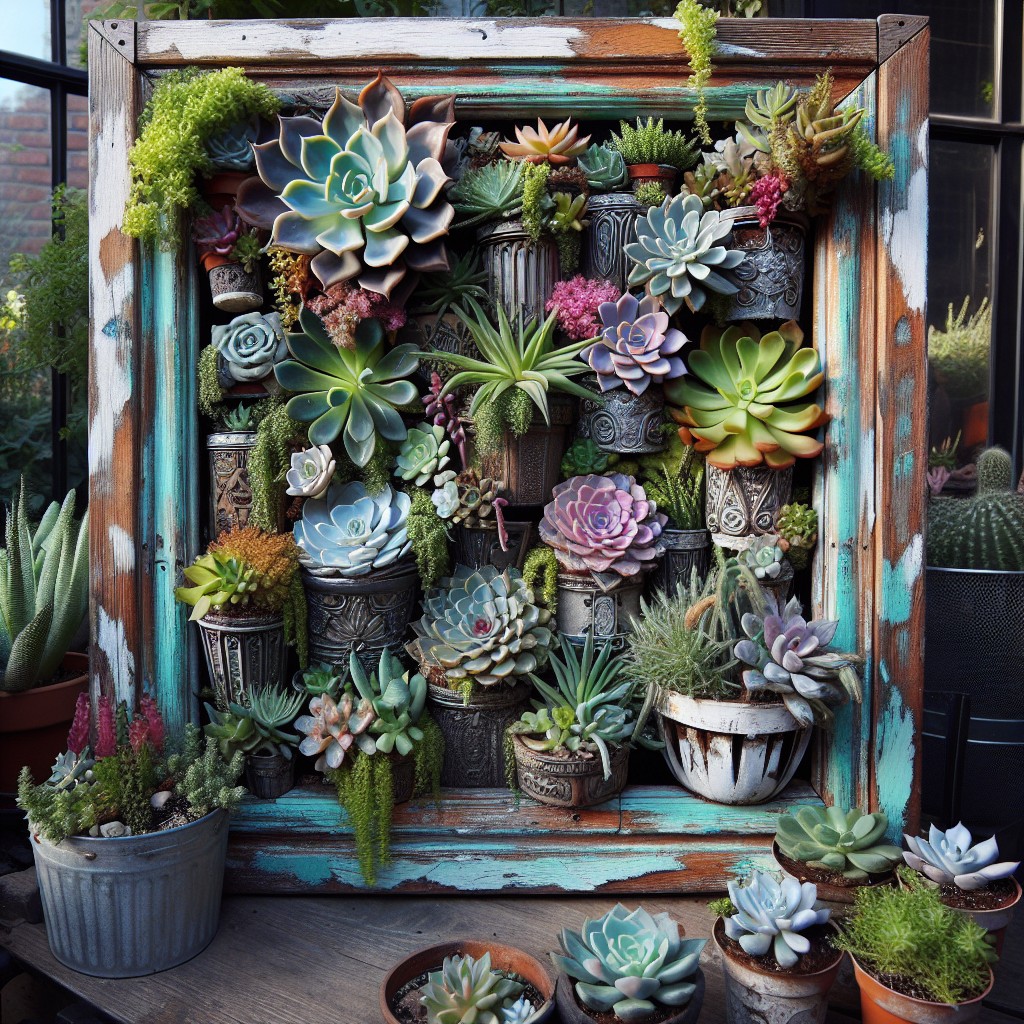
Finding recycled materials for your succulent frame project is both eco-friendly and cost-effective. Look around your home for items that can be repurposed. Old wooden picture frames can be sanded and painted to bring them back to life. Discarded wooden pallets, with a bit of creativity, can turn into rustic and charming backdrops for your plants.
Broken ceramic tiles can be pieced together to create a mosaic-like border. Even outdated window frames can serve as a larger, statement piece for your succulent display.
Think creatively with the resources available to you. Mesh or chicken wire attached to the back of a frame provides excellent support for succulent soil and roots. If you’re using deeper frames like shadow boxes or drawers, they might only need a layer of moss and soil before they’re ready to house your plants.
For a personal touch, consider integrating small, memorable items that can withstand the soil’s moisture. Small figurines, shells collected from a beach visit, or pebbles from a hike can make your frame a story-filled centerpiece.
By using recycled materials, not only do you create a unique, handcrafted decor piece, but you also contribute to the sustainability effort by giving a second life to what might otherwise end in a landfill.
Outdoor Vs. Indoor Succulent Frames: What to Consider
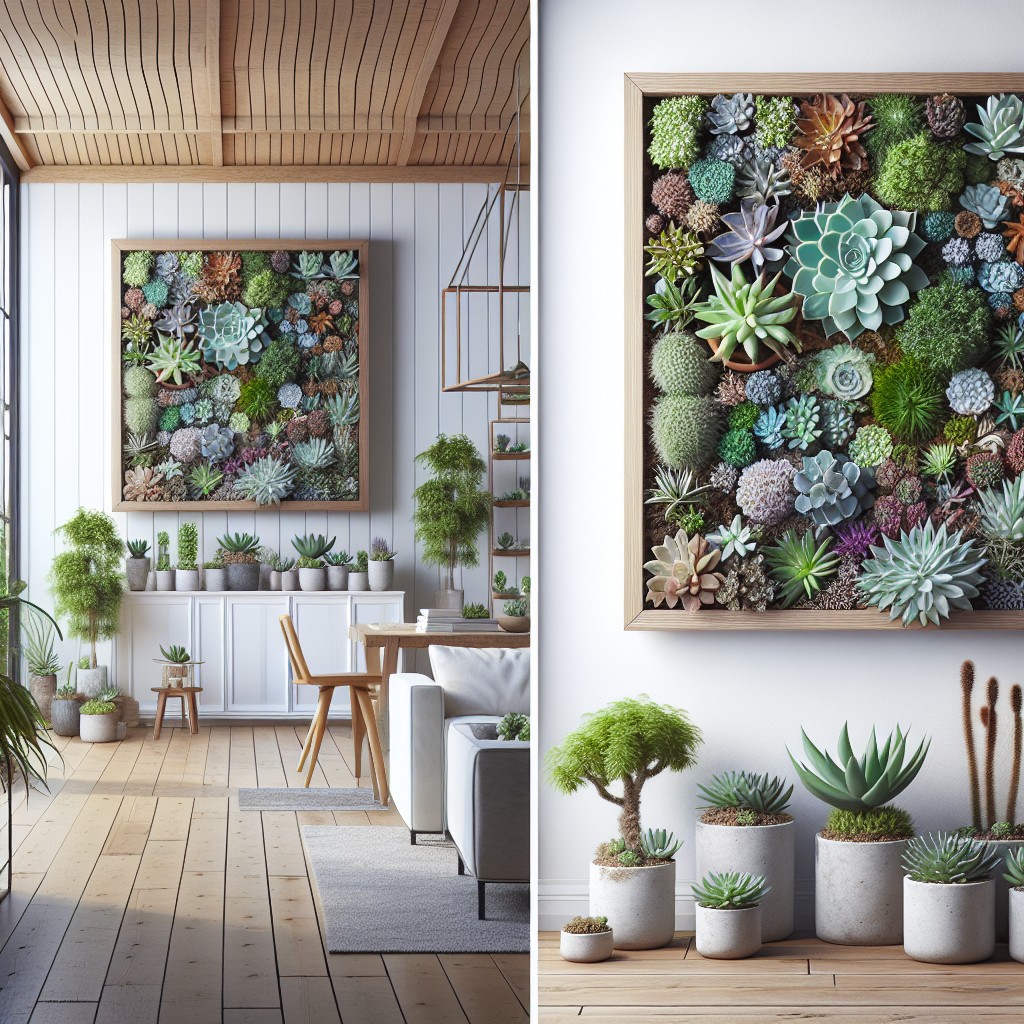
When deciding between an outdoor or indoor display for your succulent frame, consider these pivotal factors:
- Exposure to the Elements: Outdoor frames must withstand weather changes, so choose hardy succulents and weather-resistant materials.
Sunlight: Succulents thrive in good lighting. Indoor frames should be placed where they receive plenty of indirect sunlight, whereas outdoor frames can handle more direct sun.
Temperature: Outdoors, succulents can endure the natural temperature range. Inside, avoid placing frames near heat sources or drafts.
Watering Needs: Outdoor frames may benefit from natural rainwater, but be cautious of overwatering. Indoors, succulent frames require a more controlled watering schedule to prevent root rot.
Mobility: Indoor frames are easier to move, allowing you to manage light exposure and aesthetic placement. Outdoor frames should be positioned thoughtfully as they will likely remain stationary.
Size and Scale: Smaller frames work better indoors for compact spaces, while larger installations can make a more striking impact outdoors.
Incorporating Succulent Frames Into Your Home Décor
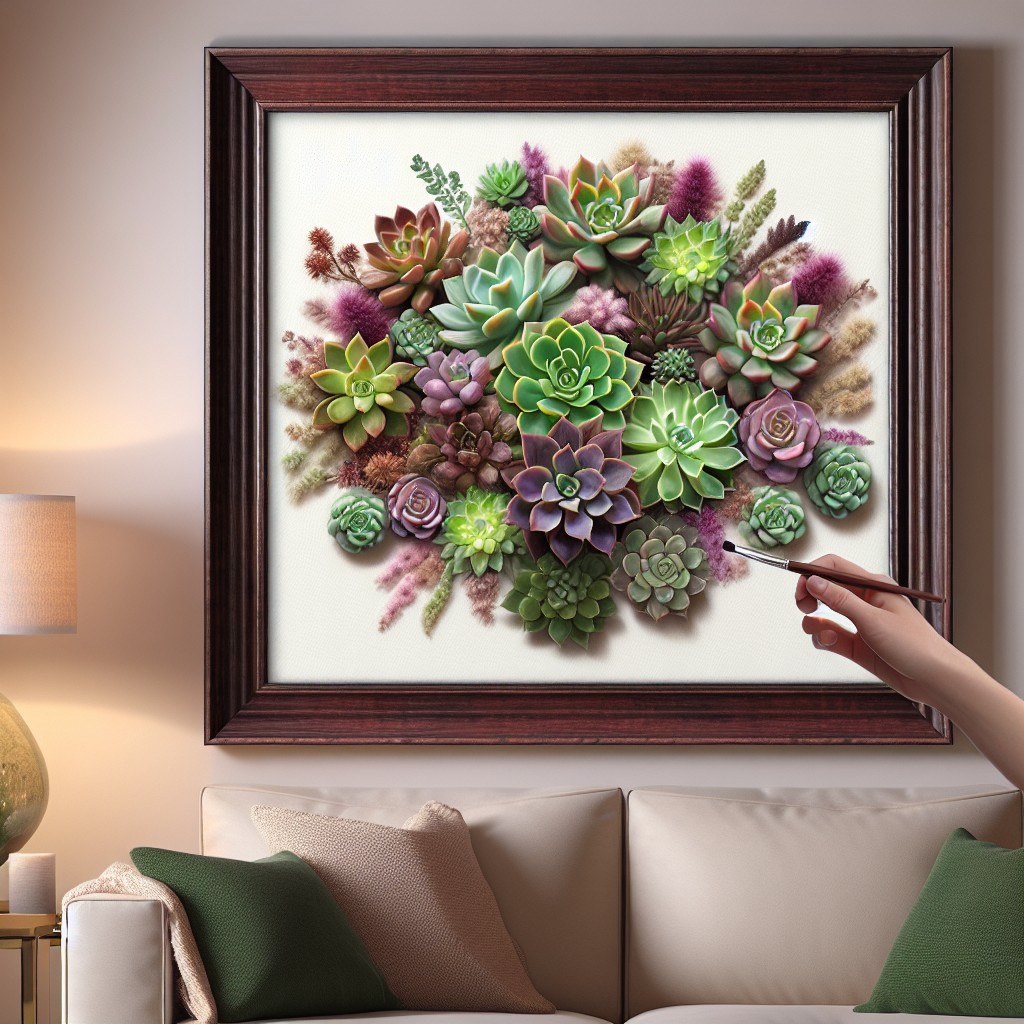
Succulent frames serve as versatile decor pieces that effortlessly complement various interior styles. Hanging one above a mantle adds an organic touch to your living space, while pairing with gallery walls can introduce texture and a splash of greenery.
Consider the lighting and humidity of the room when deciding on placement to ensure the plants thrive. To create a focal point, use a large frame as standalone wall art in an area that receives plenty of indirect sunlight. For a cohesive look, choose a frame color or material that matches your existing decor elements like wood tones or metal finishes.
In small spaces, arrange multiple miniature frames to create an impactful visual cluster without overwhelming the area. They can also double as functional decor, such as being used as elegant living table runners or placed in bookshelves between volumes to break the monotony.
Remember to rotate frames periodically to promote even growth and maintain visual interest from every angle.
DIY Holiday-themed Succulent Frames
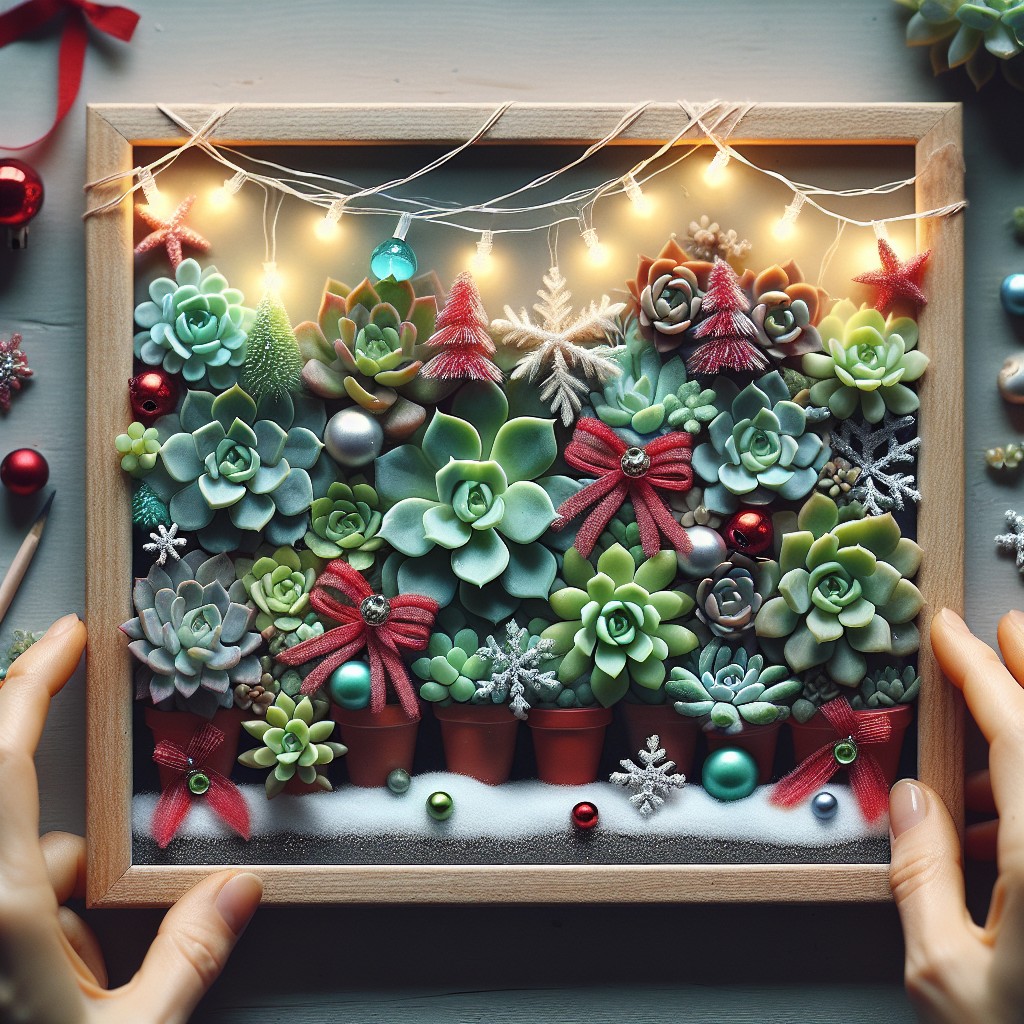
Transition your succulent frames into festive decor with seasonal elements such as pinecones, ribbon, or holiday-colored pebbles. Consider arranging succulents that have red, green, or white hues to evoke traditional holiday spirit.
Incorporate miniature ornaments or fairy lights for an extra twinkle, and remember, you can gently tie these decorations to your plants without damaging them.
Should you choose to create a gift, personalize the frame with touches that reflect the recipient’s holiday style. Remember, using a moisture-resistant backing will help preserve the frame when watering, keeping it functional and beautiful throughout the season.
Unique Ways to Display Your Succulent Frame
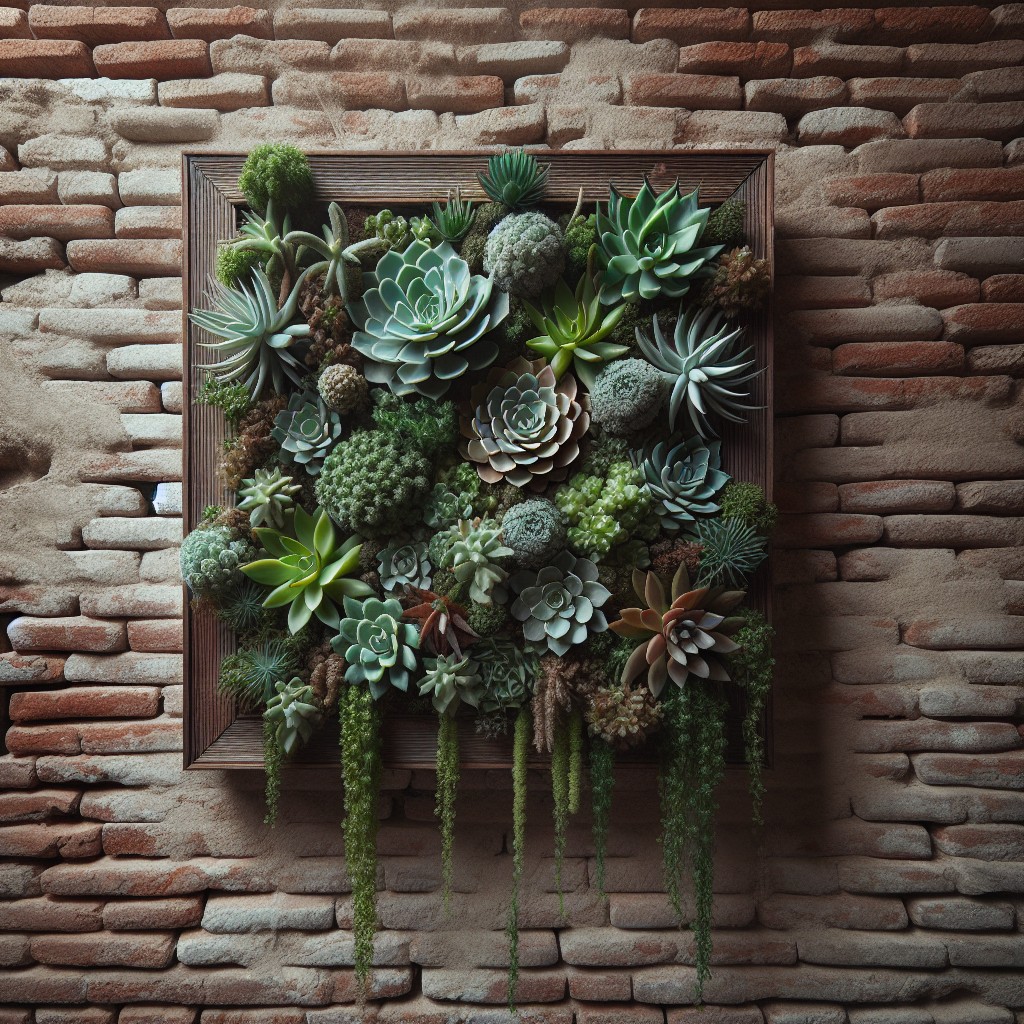
Transform a corner of your room into a green oasis by clustering different-sized succulent frames in a tiered fashion, allowing each piece to be distinctly visible while creating a cohesive botanical gallery.
Incorporate your framed succulent art into a mixed-media wall by adding shelves with various potted plants and decorative items that complement the textures and colors of your succulents, blending nature with your existing décor.
Suspend your frames from the ceiling with sturdy hooks and adjustable ropes or chains for a hanging garden effect. This floating arrangement can serve as a room divider in open spaces or as a living, breathing mobile.
Consider a seasonal rotation for your succulent frames, where each change of season brings new thematic elements. Attach small hooks around the frame to dangle seasonal ornaments, like fairy lights in winter or butterfly motifs during spring, to keep the display fresh and engaging.
For a truly innovative display, integrate your succulent frames into functional pieces of furniture. A coffee table outfitted with a recessed, transparent top can house a succulent frame, turning a simple piece of furniture into a conversation starting centerpiece.
Using Various Succulent Types in a Single Frame
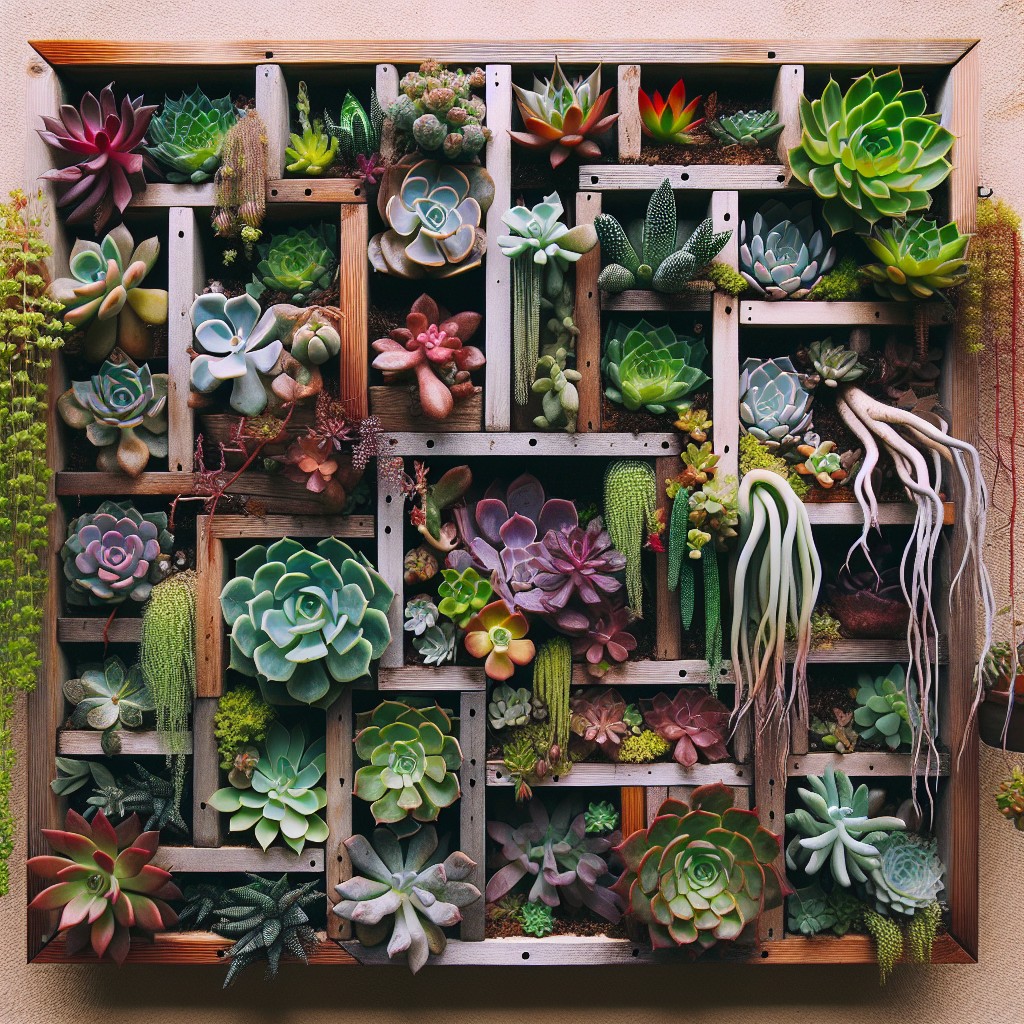
Incorporating a variety of succulents into one frame can create a captivating display of textures, colors, and shapes. When assembling your selection, consider the following:
- Mix rosette-shaped succulents like Echeveria with spiky types such as Haworthia to add contrast.
- Pair plants with similar water and light needs to ensure your frame thrives.
- Use a combination of trailing succulents, like String of Pearls, at the frame edges for a cascading effect.
- Contrast colors by placing lighter, blue-toned succulents next to deep greens or vibrant purples.
- Vary plant sizes for depth and visual interest, arranging larger specimens as focal points surrounded by smaller ones.
- Remember that some succulents grow faster than others; balance fast-growers with slow-growers to maintain your design over time.
- Factor in the texture – smooth-leaved varieties complement those with fuzzy or jagged edges.
By following these considerations, your succulent frame will be a dynamic piece of living art.
Creating Minimalistic Succulent Frames
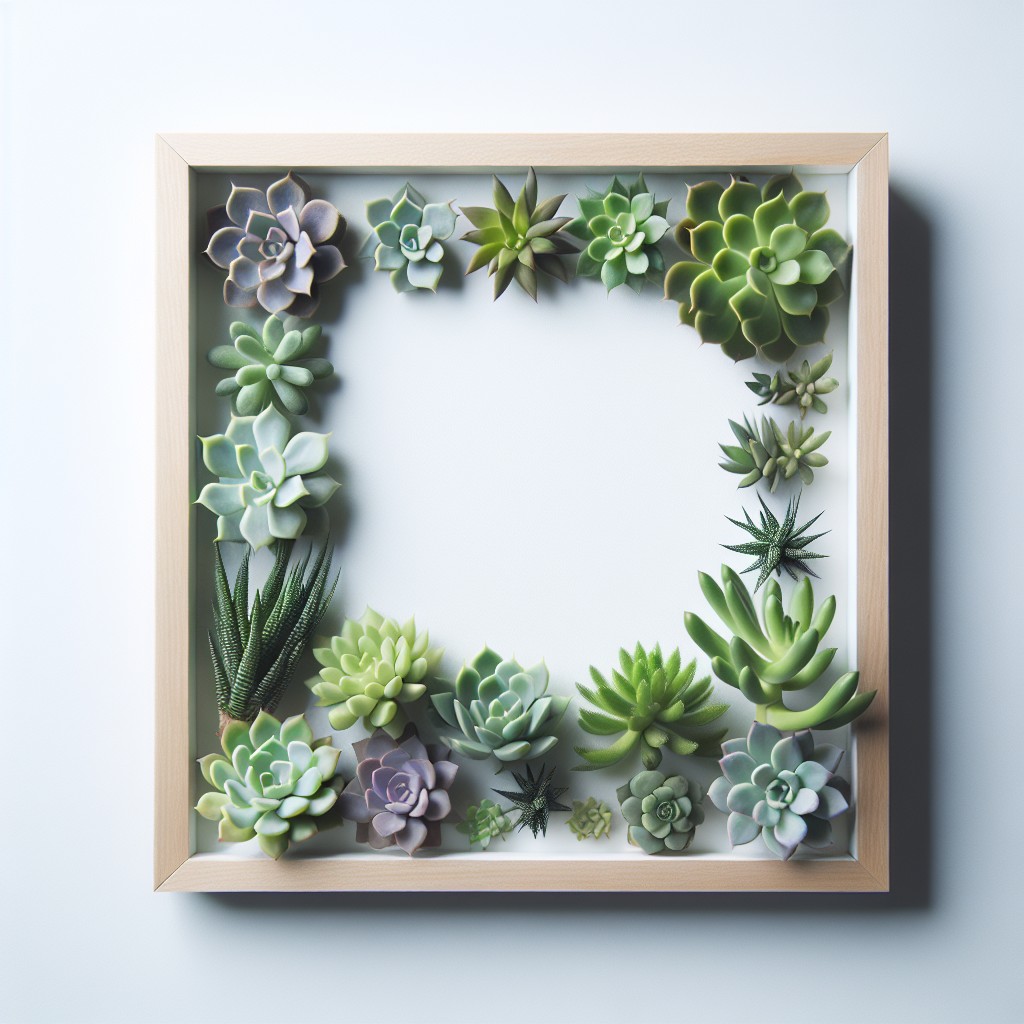
Minimalist design emphasizes simplicity and the “less is more” philosophy. To create a minimalistic succulent frame, focus on clean lines, neutral or monochromatic color palettes, and a select few types of succulents.
Here are some considerations:
- Choose a simple frame with straight edges and a uniform color. White, black, or natural wood are ideal for a minimalist look.
- Opt for succulents with geometric shapes for a sleek appearance. Species like Echeveria and Haworthia are excellent choices.
- Arrange the plants sparsely to avoid overcrowding. Use an odd number of succulents for a visually pleasing composition.
- Select a simple substrate like fine gravel or sand in a singular tone that won’t distract from the plants.
- Avoid embellishments or decorative accessories. The focus should be on the clean beauty of the frame and the plants.
By adhering to these guidelines, your minimalist frame will serve as a serene and stylish piece of living art.
DIY Framed Succulent Art for Beginners
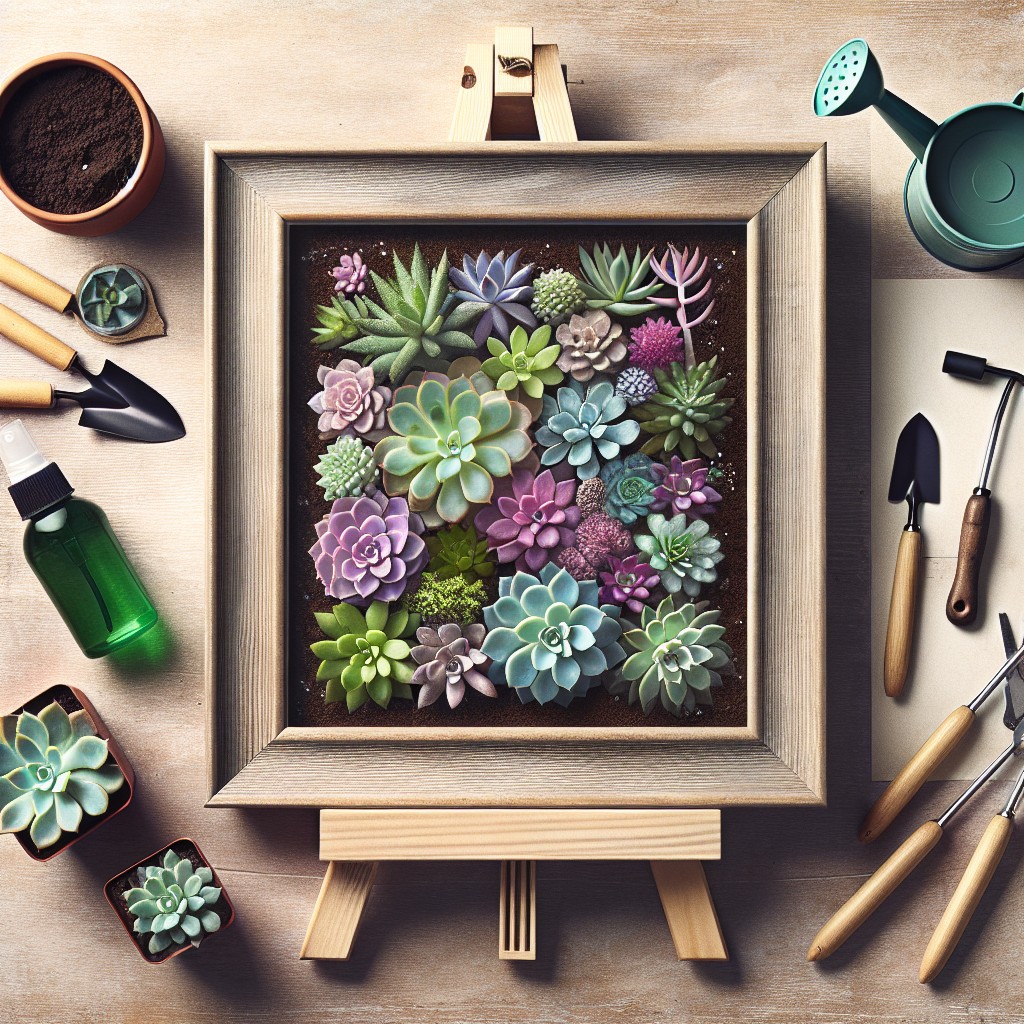
Embarking on your first DIY framed succulent art project is an exciting venture that combines gardening with crafting. Here are some foundational steps to ensure success:
Gather Materials: Start with a shallow wooden frame, mesh wire, cactus soil, and a variety of succulent cuttings.
Prepare the Frame: Seal the wood to prevent water damage and attach the mesh wire snugly to hold the soil and plants.
Select Succulents: Opt for smaller cuttings that can fit easily within the frame and grow slowly, reducing the need for frequent maintenance.
Plant Arrangement: Plan your design by positioning the succulents on the mesh before planting, considering color, texture, and height for an aesthetically pleasing arrangement.
Rooting: Once planted, give the succulents time to root by laying the frame flat and avoiding watering for a week to encourage strong root development.
Mount and Display: When roots are established, mount your frame vertically in a location that receives bright, indirect sunlight to keep the plants healthy.
Remember, patience is key as you wait for roots to take hold, and gentleness is a must when handling delicate succulent cuttings. Enjoy the process of watching your living artwork flourish!
DIY Faux Succulent Frame
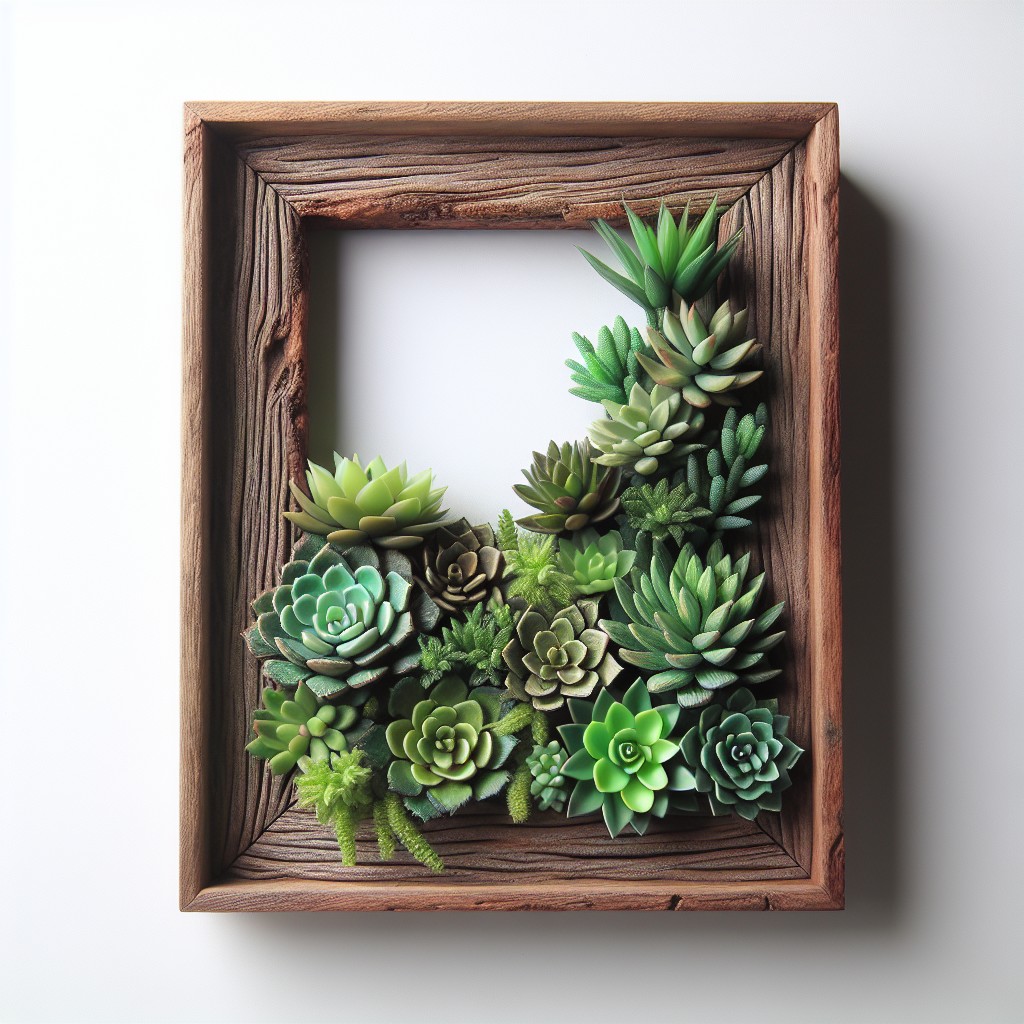
For a maintenance-free yet stylish option, consider crafting a faux succulent frame. This allows you to enjoy the aesthetic benefits without the upkeep:
- Select high-quality faux succulents for realism; look for variations in color and texture to mimic a natural assortment.
- Use a shadow box or a deep picture frame as your base, as it provides enough depth to arrange the faux plants.
- Cut foam to fit the base of the frame; this acts as an anchor for your artificial succulents.
- Map out your design before securing the plants; balance the arrangement for visual harmony.
- Attach the faux succulents by inserting the stems into the foam; use hot glue for extra stability.
- Opt for a mix of sizes and shapes to create depth and interest.
- Consider creating a background with moss or pebbles for added texture; make sure these elements are also faux to maintain the longevity of your piece.
- Mount your frame securely, as the materials can be heavier than they look.
This approach guarantees a lasting piece of greenery that stays vibrant year-round without any need for sunlight or watering.
How to Troubleshoot Common Issues With Succulent Frames
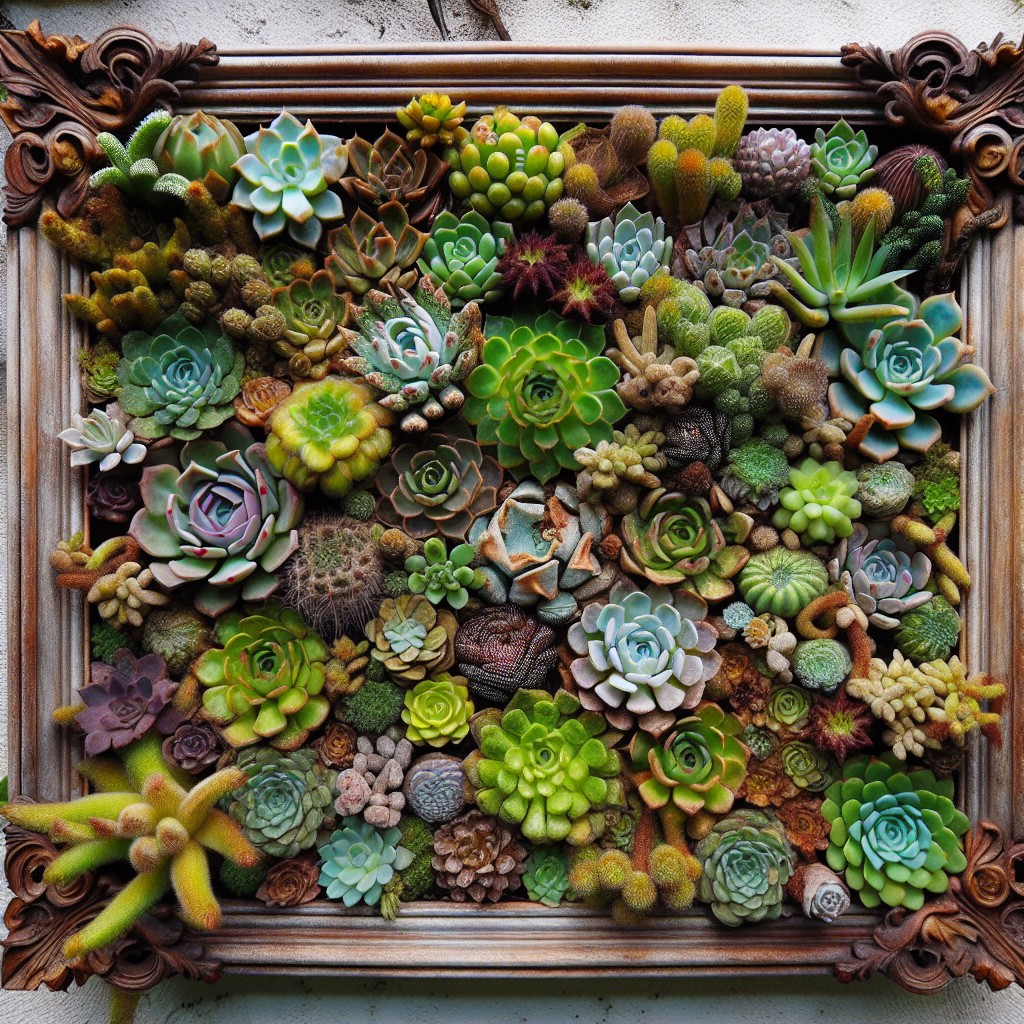
When leaves start yellowing or dropping, overwatering is often the culprit. To correct this, let the soil dry out completely before the next watering. If roots appear mushy, remove the succulent from the frame, trim away the affected parts, and replant in dry soil. Conversely, wrinkled leaves signal underwatering—address this by gently increasing water frequency.
Succulents leaning or stretching towards light indicate insufficient exposure. Find a brighter spot for your frame, but avoid direct harsh sunlight that may scorch the leaves. If pests like mealybugs or spider mites invade, dab them with cotton swabs soaked in alcohol or employ insecticidal soap as a safe remedy.
Finally, if your frame seems overgrown, it’s time to prune. Carefully clip away crowded sections to maintain the arrangement’s shape and avoid mold from lack of airflow. With these tips, keep your framed succulent display healthy and visually appealing for years to come.
Benefits of Having a Succulent Frame At Home
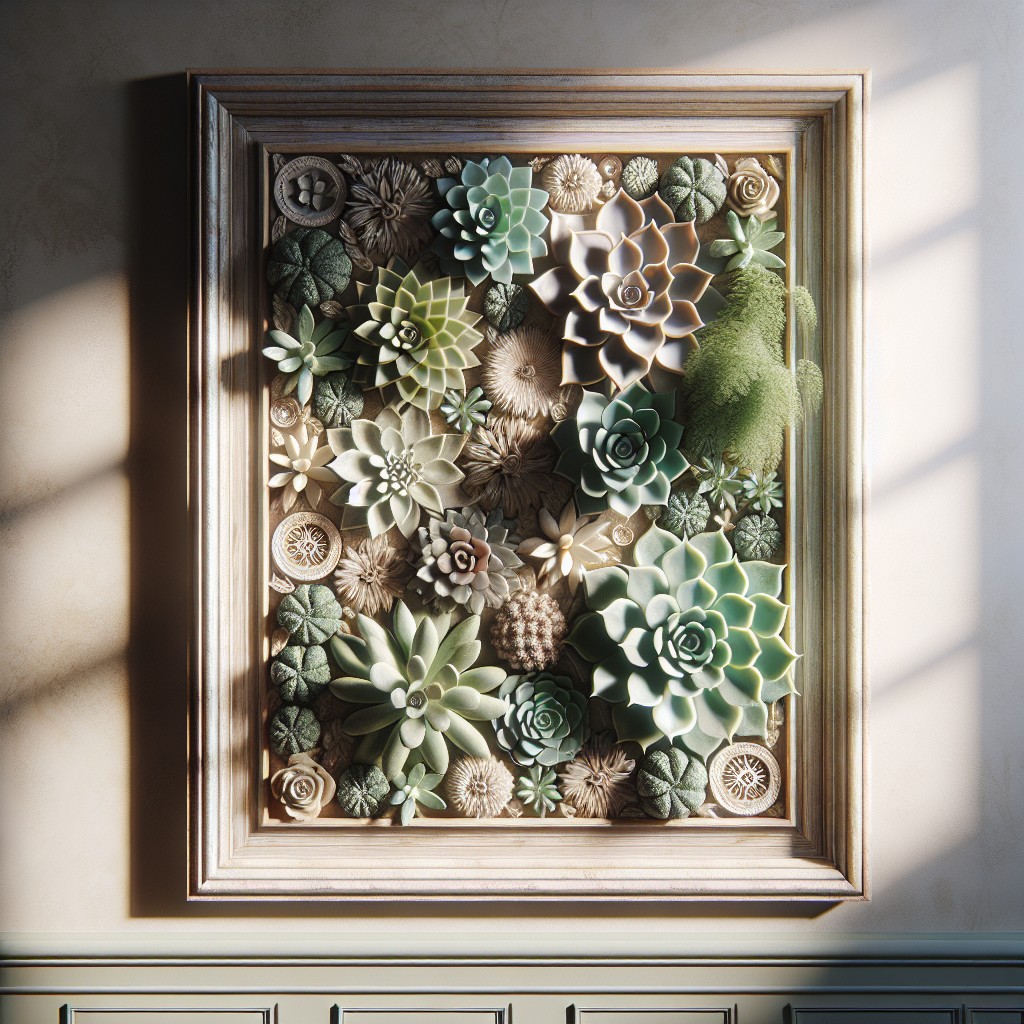
Succulent frames are more than just decorative — they’re a multifaceted addition to your home. They infuse a touch of greenery into your space, which can inspire a peaceful and calming atmosphere. This aspect of bringing nature indoors is not only aesthetically pleasing but also contributes to your mental well-being.
Moreover, these live art pieces demand minimal maintenance. Their drought-tolerant nature means less watering and care compared to other houseplants, making them ideal for busy individuals or those new to plant nurturing.
The versatility of succulent frames is another advantage. They can be positioned to suit various light conditions and can thrive in different rooms, whether on a sunny kitchen windowsill or a shaded living room wall.
Space efficiency is yet another benefit. Vertical succulent gardens are perfect for small apartments or homes lacking in floor space. By using wall or hanging frames, these creations allow you to cultivate a varied plant collection without sacrificing valuable living space.
Plus, the creative process of designing a succulent frame provides a therapeutic outlet, giving you a chance to unwind and express yourself through the arrangement of textures and colors. This activity not only results in a unique piece of home decor but also grants a sense of accomplishment and pride in your DIY efforts.
DIY Succulent Frame: Step-by-Step Photo Guide
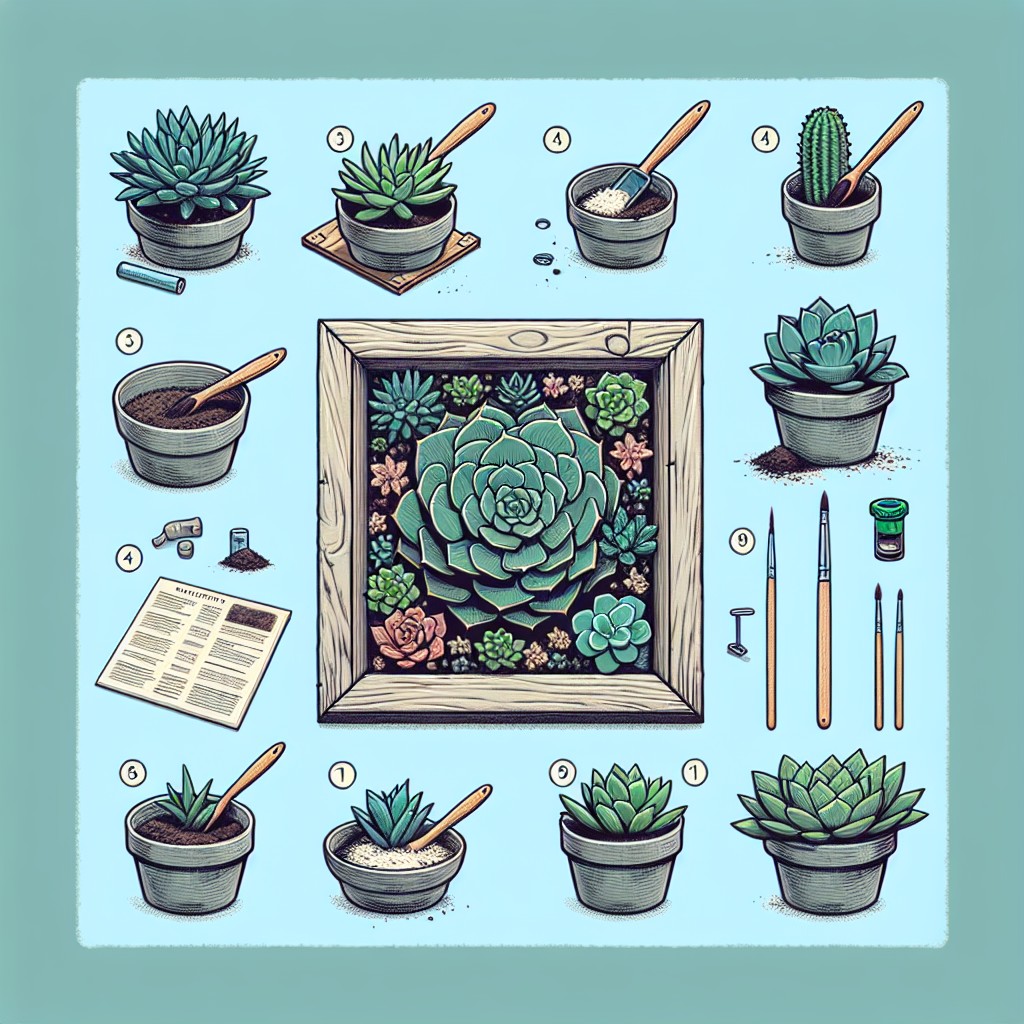
Begin with a well-structured frame, ensuring it’s sturdy enough to hold soil and plants. A shadow box or a deep picture frame work best.
Line the frame with plastic or waterproof material to protect the wood and prevent water damage. Secure with a staple gun for a firm hold.
Attach a wire mesh across the front of the frame, this will hold your succulents in place. Trim the mesh to fit, then staple or nail it securely.
Select soil specifically designed for succulents and cacti, as proper drainage is essential. Fill the frame with soil, pressing it through the mesh.
Choose a variety of succulents for visual interest. Consider different colors, textures, and growth patterns.
Plant your succulents by making small holes in the mesh and inserting the roots into the soil. Use a tool like a pencil or chopstick to help.
After planting, leave your frame flat for 1-2 weeks to allow roots to establish, preventing them from falling out when you hang it up.
Once roots are set, water sparingly. Succulents thrive in well-draining soil and don’t require frequent watering.
Capture each step with high-quality, well-lit photos. Show close-ups of the mesh attachment, soil filling, planting technique, and the finished project.
Include captions with your photos to provide additional tips, such as how to choose plants for texture and color balance, or how to water the frame without making a mess.
Creating a Seasonal Succulent Frame
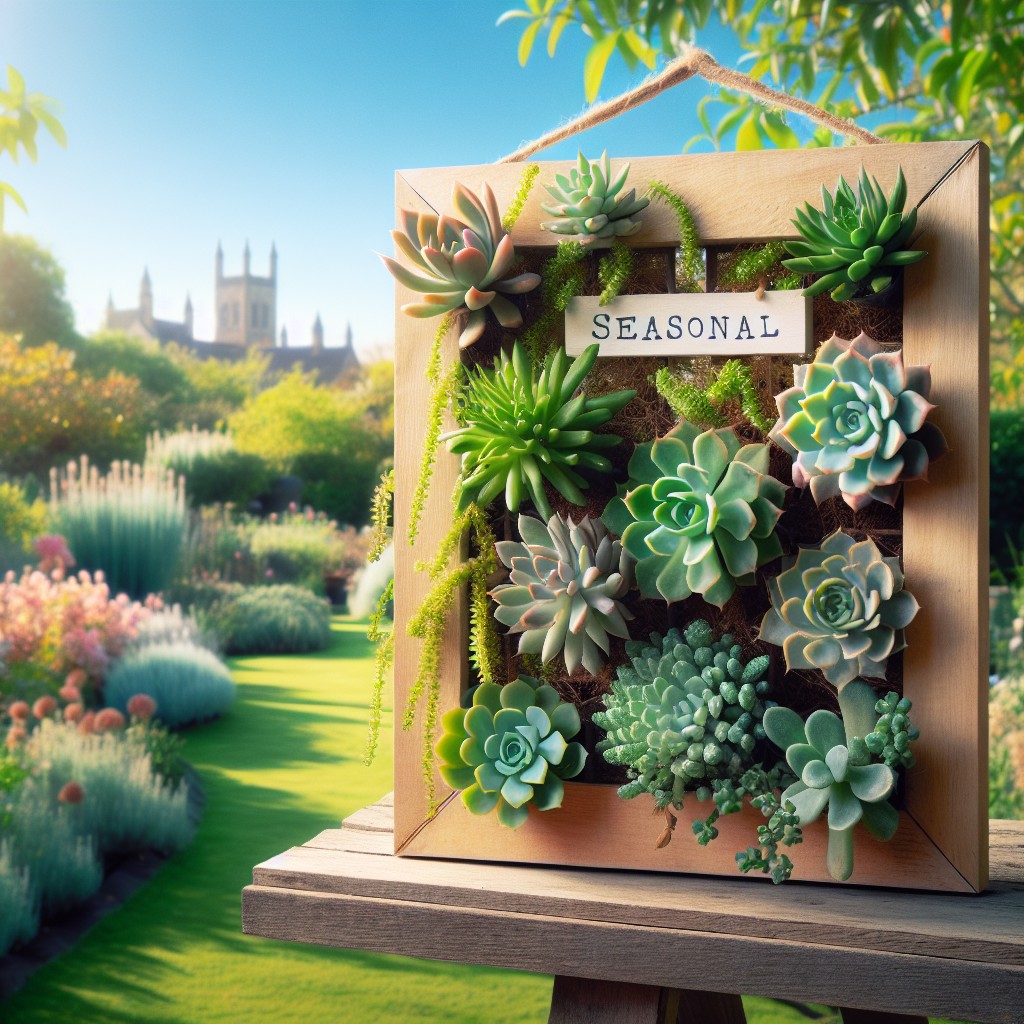
Embrace the changing seasons by adapting your succulent frame to reflect the time of year. Here’s how:
- Spring Palette: Choose bright, fresh greens and flowering succulents to mirror the new growth of spring.
- Summer Vibrancy: Select succulents with warm tones, such as reds and yellows, to resemble the summer sun.
- Autumn Earthiness: Incorporate succulents with deep purples, oranges, and browns to evoke the cozy essence of fall.
- Winter Wonder: Use silver and blue-toned succulents to capture the frosty feel of winter, perhaps even adding touches of white to imitate snow.
For a festive spin, intersperse seasonal decorations like mini pumpkins in fall or tiny ornaments during the winter holidays. The key is to keep the frame’s look cohesive with the seasonal theme by aligning your choice of plants and accessories. Remember to adjust care slightly as some succulents go dormant in different seasons. With each season transition, your frame provides a delightful focal point that harmonizes with nature’s own decor shifts.
Making a Vertical Hanging Succulent Frame
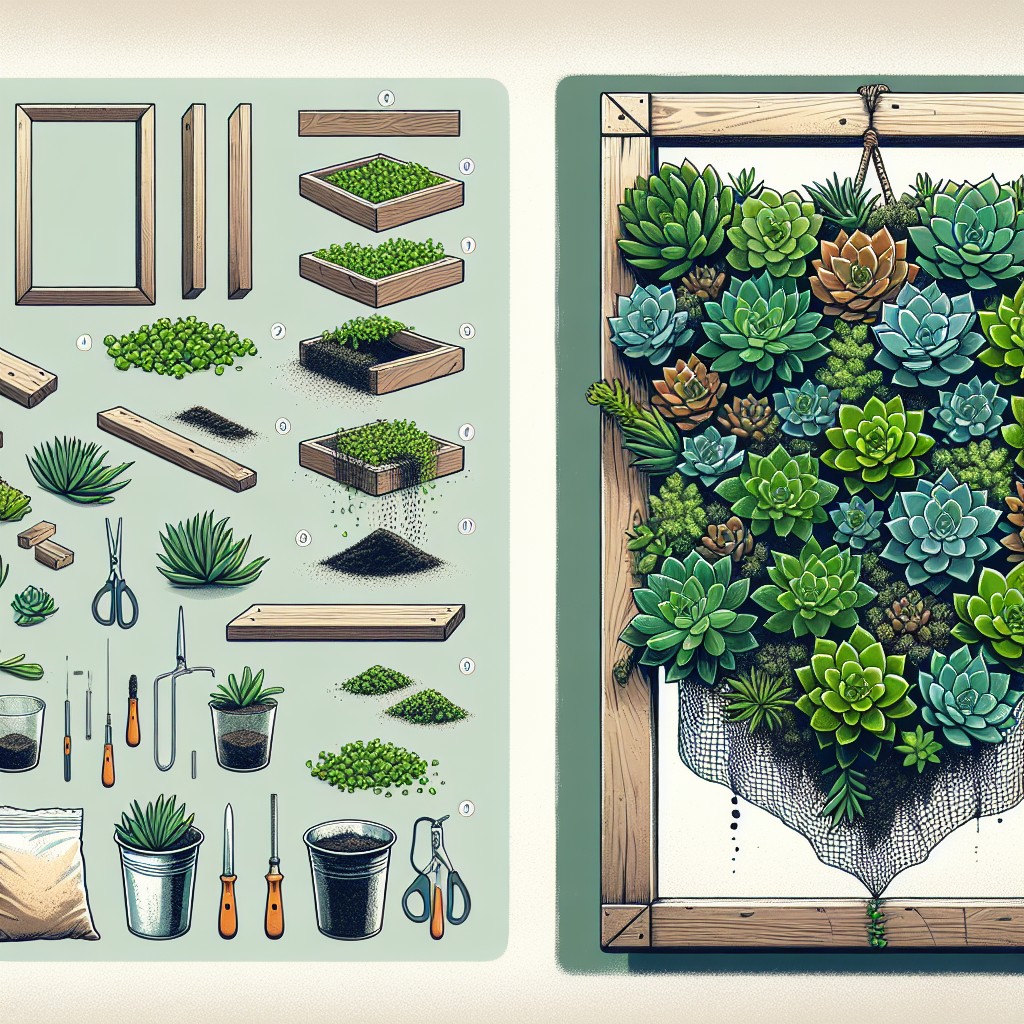
Craft a sturdy framework using a shadow box or repurpose an old wooden frame by adding wire mesh to support the succulents. Ensure it’s secure, as this will bear the weight of your plants and soil.
Opt for a soil mix that’s specially designed for succulents. This will promote drainage and prevent root rot. Apply the soil behind the mesh, packing it firmly to offer support and nutrients for the plants.
Select various succulents with different textures, sizes, and colors to create visual interest. Plant them by gently inserting the roots into the mesh openings. It’s vital to leave some space between them for growth.
Attach a solid hanging mechanism to the back of the frame. This could be a strong hook or wire. Make sure it’s well anchored to support the frame’s full weight once the succulents are watered.
Begin with the frame in a horizontal position for planting and allow it to lay flat for a to week or two, depending on the climate. This lets the roots take hold and the soil to settle, minimizing the risk of plants falling out when you hang it up.
Gradually expose the frame to more sunlight over several days, which will help the succulents adapt to their new environment without experiencing shock from abrupt changes.
Once the plants are securely rooted, hang the frame vertically in a location that receives plenty of indirect sunlight. An east or west-facing wall is ideal to avoid the harsh midday sun that could damage the plants.
Regular misting will keep your succulents hydrated without overwatering them. However, be mindful of the watering needs, as too much moisture could harm the roots. The frame requires less water than potted plants.
By following these steps, you’ll create a living piece of art that breathes life into any space and stays healthy with minimal maintenance.
Multi-dimensional Succulent Frames: A New Challenge

Tackling multi-dimensional succulent frames adds depth and visual interest to any space. By layering different sizes and textures of succulents, you create a living sculpture.
Start with a sturdy base, such as a shadow box or a deep picture frame, to accommodate the added dimension. Use a variety of succulents, from rosettes to trailing varieties, to give the illusion of movement and depth.
Incorporate moss, stones, or driftwood between the layers for a natural aesthetic. Secure the composition with floral glue or wire, mindful of growth patterns and sunlight needs. Regular pruning will maintain shape and encourage fuller growth, enhancing the frame’s multi-dimensional effect.
Remember, this project requires patience, but the result is a striking piece of living art that is sure to captivate.
How to Transplant Pre-grown Succulents Into a Frame

Start by removing the succulents gently from their current containers, taking care not to damage their roots. Shake off excess soil, teasing the roots apart slightly to encourage them to spread out in their new environment.
Prepare the frame by filling it with a pre-mixed succulent or cactus soil, which offers the ideal drainage and nutrients. Ensure your frame is backed with a wire mesh or similar material to hold the soil in place while allowing the succulents to grow through.
Position the succulents onto the soil in a design that pleases you. Be mindful of their growth patterns and space them out accordingly. Once you’re satisfied, press the roots into the soil. Do not water immediately as this could cause the roots to rot since they’ve been disturbed.
To secure the plants, use floral pins or wire pieces, be gentle to avoid damage. This step is crucial as it prevents the succulents from shifting while they’re taking root.
Maintain the frame flat and in a bright, indirect light area for about 4-7 days to allow the plants to establish. Water sparingly once the roots are anchored and the plants show signs of new growth.
For wall-mounted displays, keep the frame horizontal for an additional period until the succulents are firmly rooted, which typically takes around 4-6 weeks. Rotate the frame occasionally to ensure even growth before finally hanging your work of art.
Teaching Kids About Plants Through DIY Succulent Frames

Engaging children in creating a DIY succulent frame is a wonderful way to cultivate an interest in plant life and responsibility. It offers a tactile learning experience where they can discover the needs of different succulent species.
Here’s how to turn this project into an educational moment:
- Responsibility: Assign them specific tasks such as watering, which teaches them about routine care.
- Botany Basics: Explain how succulents absorb water through their leaves and why they require less water than other plants.
- Ecosystem Understanding: Discuss the natural habitats of succulents and how they contribute to their ecosystem.
- Art Meets Science: Allow them to arrange the succulents creatively, bridging aesthetics with horticulture.
- Growth Observation: Encourage daily observations, fostering patience and the excitement of watching growth and changes over time.
- Recycling and Upcycling: Use old frames to start the project, illustrating the value of reusing materials.
By integrating education with hands-on activity, children gain a deeper appreciation of nature and the joys of gardening, even in small-scale projects like a succulent frame.
Creating a Succulent Frame Centerpiece for Your Table
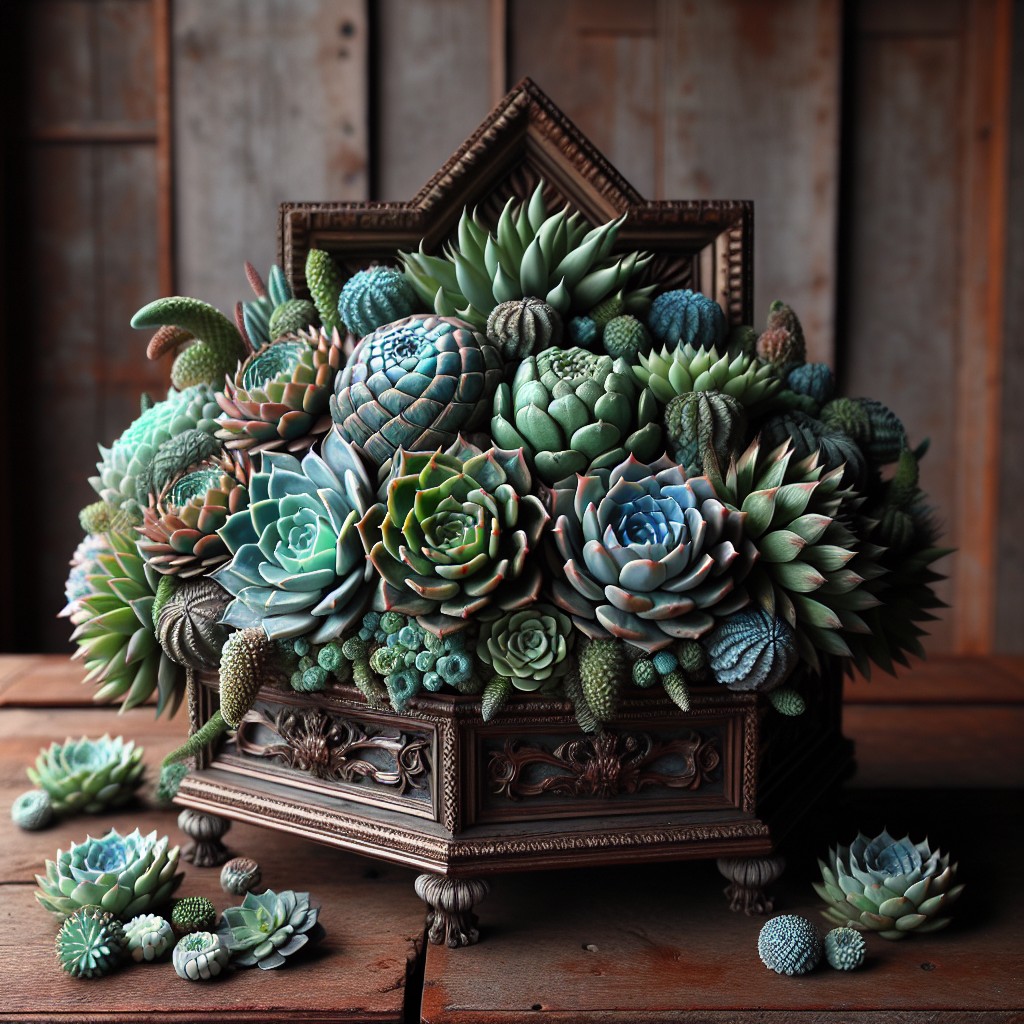
To craft a captivating centerpiece with succulents, start by selecting a shallow, open frame that complements your table aesthetics—think wood for rustic charm or metallic for a modern touch. Ensure the frame depth accommodates the roots without overwhelming the table.
Secure a wire mesh firmly to the frame’s back as a base for your succulent arrangement. This not only holds the soil but also provides an anchor point for the plants. Before filling with soil, consider a layer of sphagnum moss to retain moisture and prevent soil from falling through the mesh.
Position your chosen succulents, playing with height and texture for visual interest. Remember, balance is key; odd numbers often yield a more natural look. Echeverias for rosette shapes or trailing variants like String of Pearls can add flow.
Once planted, allow the succulents to root themselves for a few weeks before fully displaying the centerpiece. This ensures they stay in place and remain vibrant for entertainment or daily enjoyment. With care, your practical succulent centerpiece will be both a conversation starter and a testament to your creative prowess.
DIY Succulent Frame: The Perfect Housewarming Gift
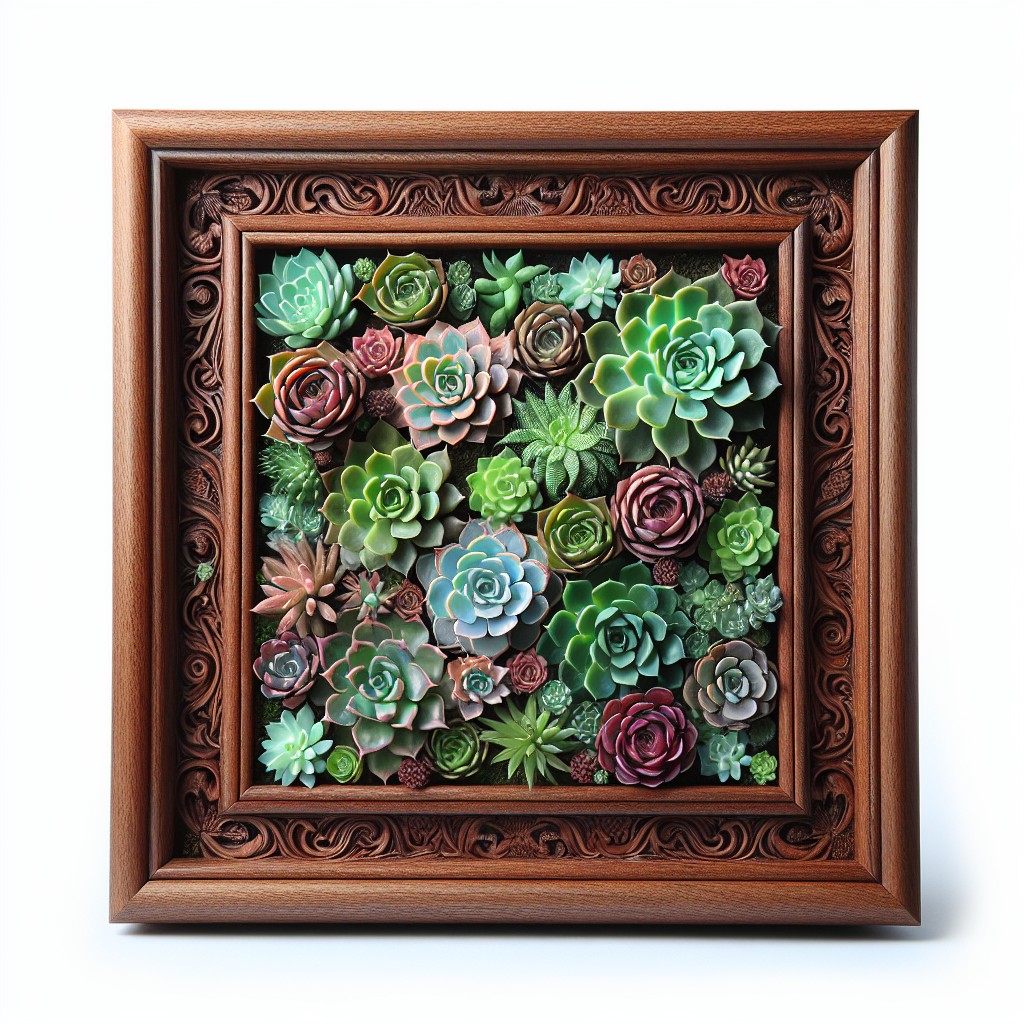
Creating a personalized succulent frame elevates a housewarming gift from pleasant to unforgettable. Start by considering the recipient’s taste—choose a frame that matches their decor style. Rustic wood suits bohemian homes, while metallics add a touch of modernity.
Opt for hardy succulent varieties that require minimal care, such as echeverias or sempervivums, ensuring a low-maintenance gift. Planting these in a shallow soil bed with proper drainage will contribute to their longevity.
Incorporate their favorite colors through varied succulent shades or decorative moss. By adding a thoughtful note with care instructions on the back, you provide guidance for upkeep. This bespoke, living artwork demonstrates both thoughtfulness and creativity, making for a cherished and lasting addition to their new home.
Succulent Frame Maintenance and Care Guide
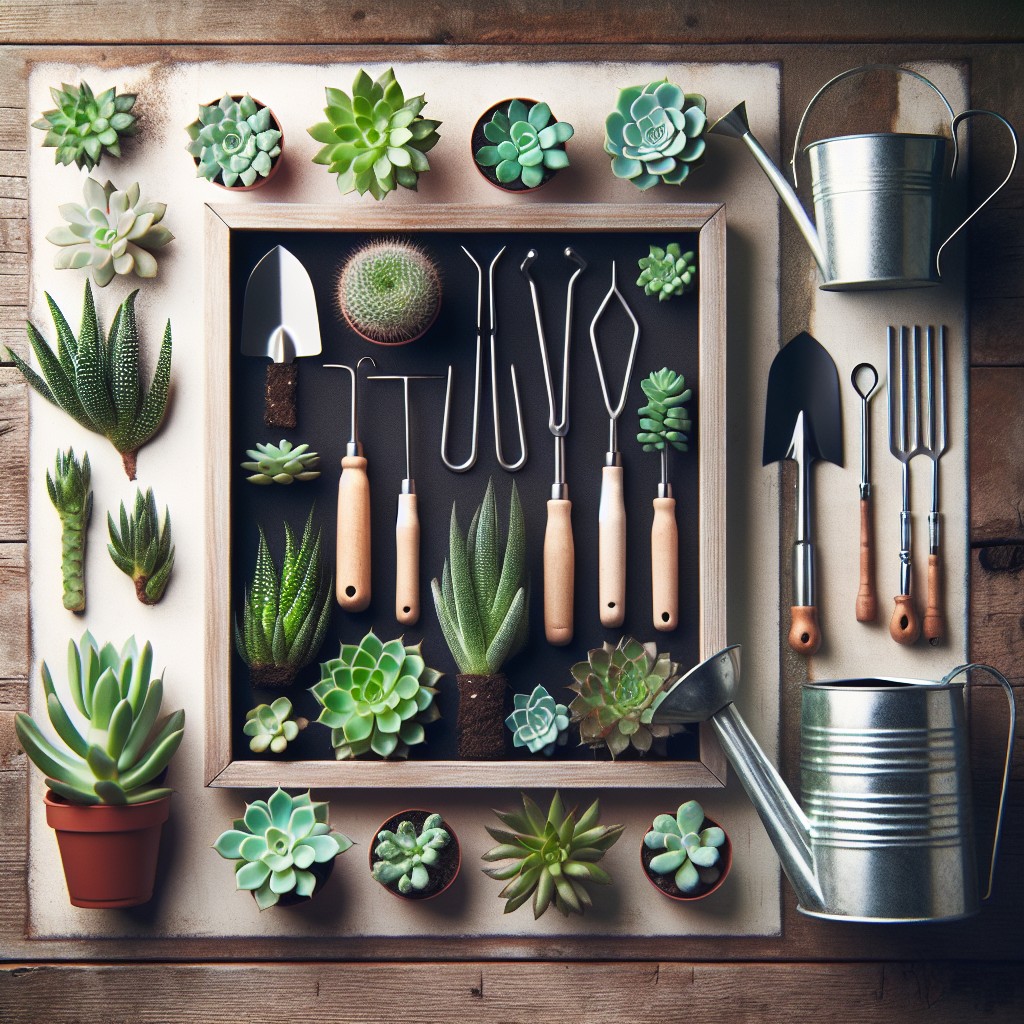
Maintaining your succulent frame ensures its longevity and the vibrancy of your plants. First, water sparingly; succulents thrive in arid conditions. Use a spray bottle to mist the soil when it’s completely dry, typically every 7-10 days. Overwatering can cause root rot, so it’s better to underwater than overdo it.
Position your frame in a space with ample indirect sunlight. Direct sun can scorch the leaves, while too little light can weaken the plants. Rotate the frame occasionally for even light exposure, promoting balanced growth.
Fertilize lightly during the growing season with a half-strength succulent fertilizer to provide essential nutrients without overwhelming the plants.
Prune as needed to remove dead or overgrown foliage, encouraging healthy growth and maintaining an aesthetically pleasing arrangement. Use tweezers or small tools to access tight spaces without damaging neighboring plants.
Lastly, watch for pests like mealybugs or aphids. Isolate any affected plants and treat them with insecticidal soap or neem oil to prevent spread. Regular observation and prompt action are key to a healthy succulent frame.
Reusing Old Succulent Frames for New Projects
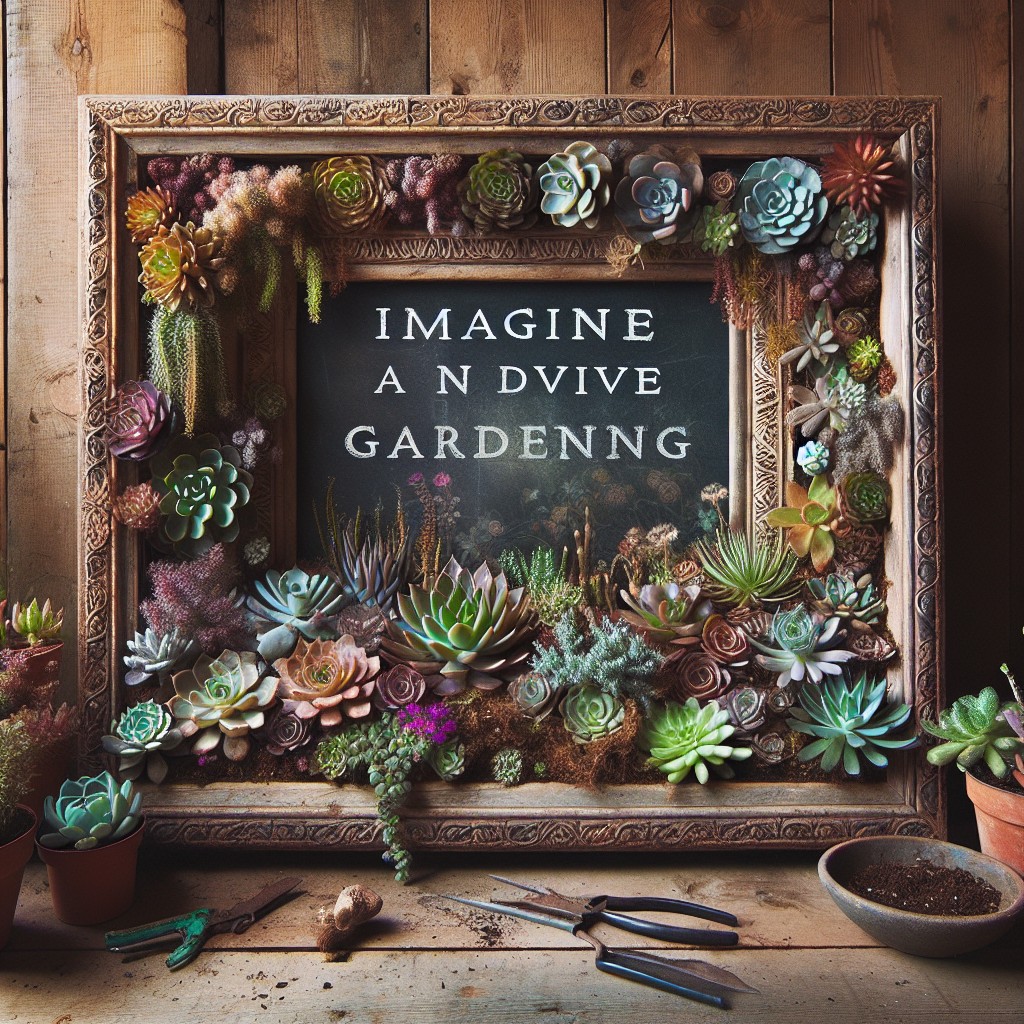
As your succulent frame matures, some plants may outgrow their space or the design might need refreshing. This presents the perfect opportunity to reuse your frame for a new venture. Here’s how:
- Repot Overgrown Succulents: Gently remove larger plants and repot them, creating room to experiment with new, smaller succulents or a different layout in the frame.
- Refresh the Soil: Take this chance to replace old, compacted soil with fresh, nutrient-rich mix, ensuring a healthy growth environment for new plantings.
- Change the Theme: If the frame has a once-trendy color or style that’s now outdated, paint or decorate the frame to fit current design trends and give it a new lease on life.
- Implement Design Variations: Replant with a variety of textures and colors, or organize the succulents into patterns or shapes for a fresh look.
- Fix Structural Wear and Tear: Before replanting, repair any damage to the frame to maintain its structural integrity and avoid future issues.
By following these points, you can ensure your succulent display remains dynamic and continues to complement your evolving decor style.
Quick and Easy Succulent Frame Projects for Busy Individuals
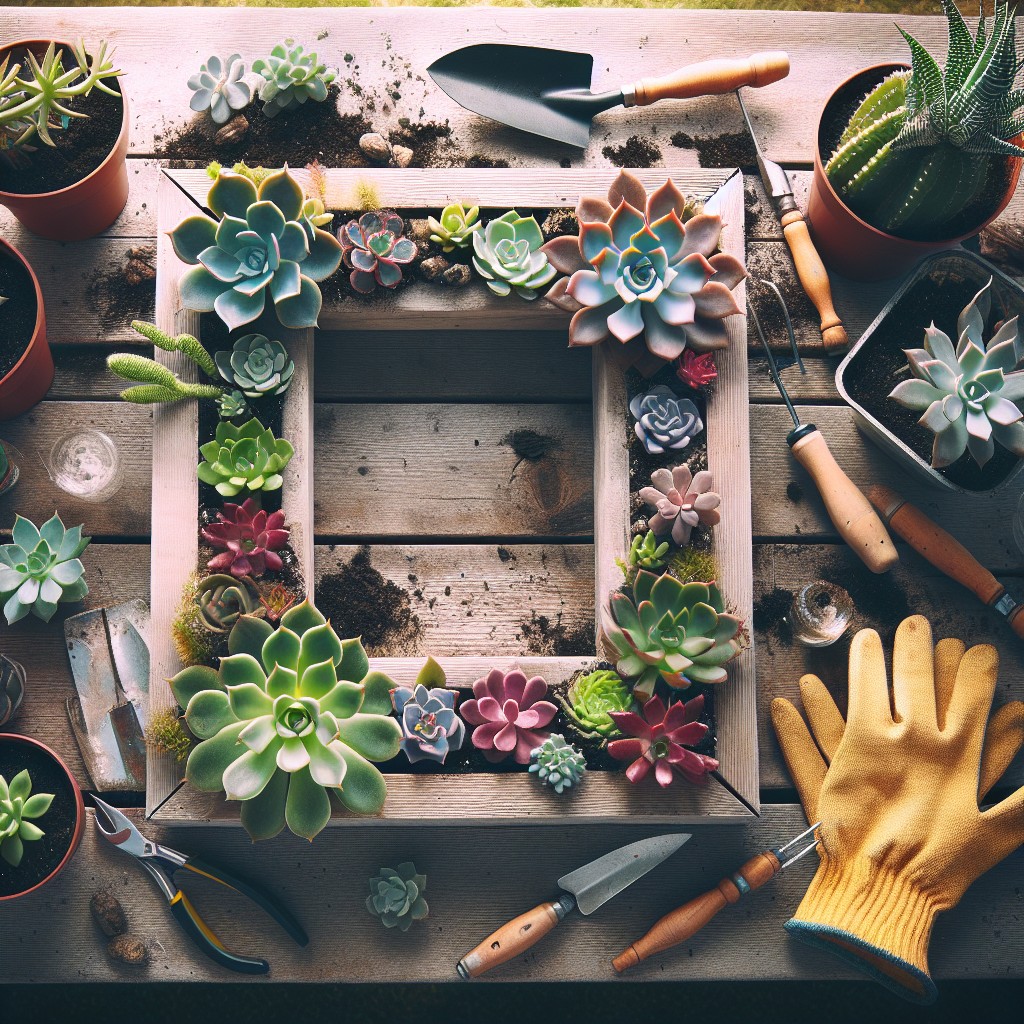
For those with packed schedules, creating a beautiful succulent frame doesn’t have to be time-consuming. Here are some tips to ensure this project fits into even the busiest of routines:
- Pre-Assembled Frames: Opt for pre-assembled shadow boxes or photo frames with depth to skip time-consuming construction steps.
- Adhesive Options: Use moss or a pre-made succulent mat as a base and attach succulents with floral glue for a no-fuss assembly that eliminates the need for soil.
- Cuttings Over Potted Plants: Choose succulent cuttings rather than potted plants. They’re easier to arrange and don’t require immediate watering, saving time on aftercare.
- One-Stop Shop: Buy all materials from one store or order a kit online to reduce shopping time.
- Batch Assembly: If making multiple frames, set up an assembly line to streamline the process. Undertake all of one step at a time before moving on to the next.
- Scheduled Maintenance: Water sparingly with a spray bottle and incorporate the frame’s care into your regular, quick home maintenance routine.
Implementing these strategies allows for the creation of a captivating succulent display that suits the lifestyle of those who are always on the go.
DIY Framed Succulent Arrangement As Wall Art
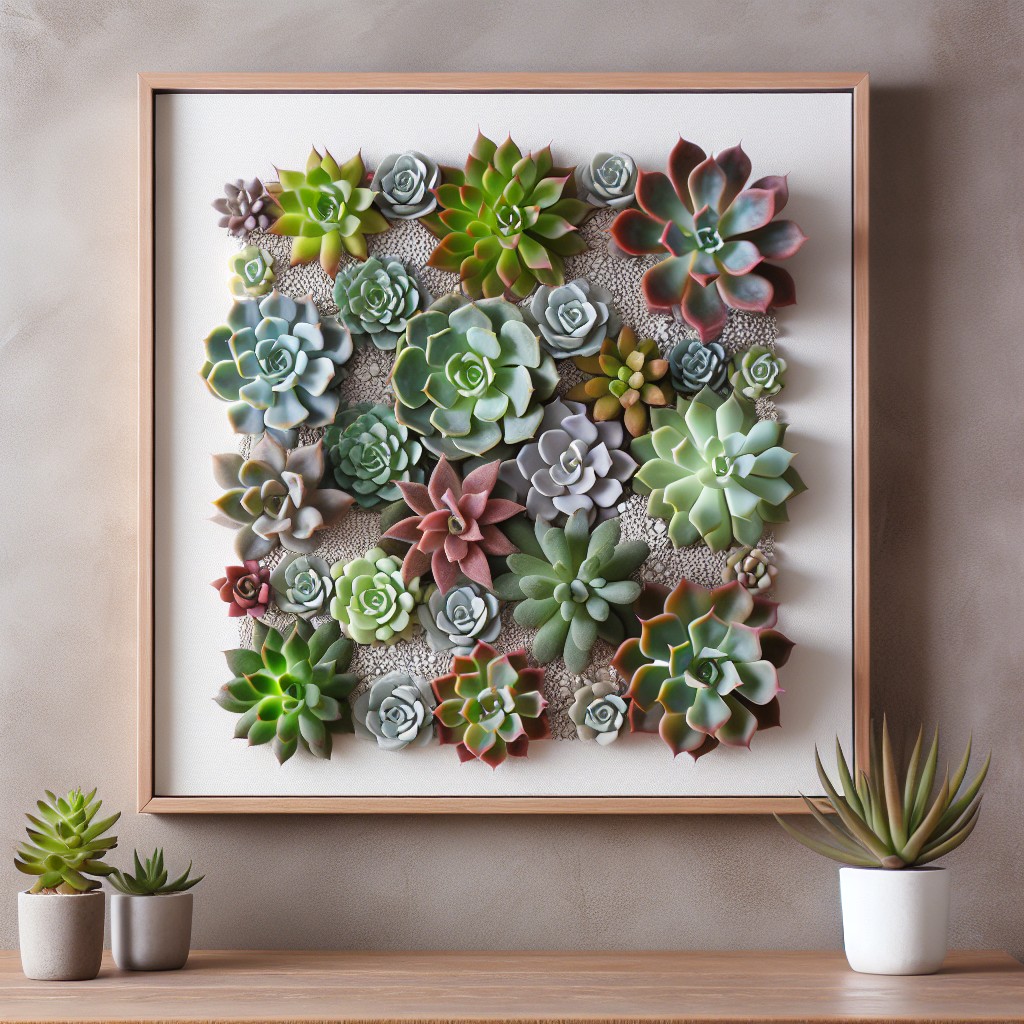
Transform any room with a touch of greenery by turning your succulent collection into a living piece of wall art. Consider these tips:
- Measure your available wall space to determine the size of your frame.
- Select a shallow wooden frame or shadow box that complements your interior decor.
- Replace the glass pane with a fine wire mesh to hold soil and plants in place.
- Line the frame with plastic sheeting to prevent water damage, and fill it with a layer of succulent-friendly soil.
- Arrange your succulents by color, size, or texture to create a visually appealing pattern.
- Secure the succulents in the soil by gently pressing the roots through the mesh.
- Allow the frame to lie flat for a few weeks, enabling the plants to root, before mounting it on the wall.
- Attach sturdy hanging hardware considering the frame’s weight post planting.
- Water sparingly and provide ample indirect sunlight to maintain your living wall art’s vibrancy.
Turn that empty wall into a statement piece that brings a fresh and natural feel to your home.
DIY Succulent Frame As a Fun Weekend Family Project

Engage the entire family in a hands-on activity that promotes creativity and teamwork with this weekend project. Here are some key points to ensure a successful experience:
- Age-appropriate tasks: Allocate simpler steps such as choosing the succulents or decorating the frame’s edge to younger participants. Older family members can handle the assembly and more intricate design elements.
- Learning opportunity: Use the project to teach about plant care and sustainability. Discuss why succulents are an environmentally friendly choice due to their low water needs.
- Customization: Encourage individual expression by allowing each family member to contribute ideas to the frame’s design. This could include paint colors, arrangement patterns, or other decorative elements.
- Team roles: Assign specific roles like project leader or materials organizer to keep everyone involved and the project on track.
- Safety first: Ensure safety when handling tools and materials. Provide gloves and use non-toxic glues or adhesives accessible to all family members.
Remember, the goal is to create not just a piece of decor but also lasting family memories.
Ideas Elsewhere
- https://www.bhg.com/gardening/container/plans-ideas/make-a-living-succulent-picture/
- https://www.lovelyetc.com/how-to-make-beautiful-diy-succulent-wall-art/
- https://myuncommonsliceofsuburbia.com/succulent-wall-planter-using-a-picture-frame/
- https://www.sunset.com/garden/backyard-projects/diy-vertical-succulent-garden-project
- https://empressofdirt.net/succulent-wall-planters/
Recap
